- Full IELTS Practice Tests
- Practice Tests

Giving the presentation
- View Solution
Solution for: Giving the presentation
Answer table.
| B | C |
| C | C |
| C | B |
| A | C |
| A | A |
Found a mistake? Let us know!
Share this Practice Test
Exam Review

Hi, Martin.
Hi, Kate. How are you?
Fine. I'm relieved to have done my presentation!
I'm sure! How did it go?
Kate: Oh, OK in the end, but I was ever so nervous beforehand . It's silly, because I do know my stuff quite well. I must know those statistics (C) inside out, but when you have to get each table of results to come up in the right order, it can make you nervous. It was my first time using the computerised projector, and I was sure I was going to get the controls wrong (B) , or something. And of course, that's not a good situation, if you know you've got to listen to questions carefully, and be ready to answer quickly (A) .
Look at Question 1 . The question consists of two parts: ' Before giving her presentation ' and ' Kate was worried about '. This is what you must listen for.
These are some dangers in choosing an answer:
- You hear Kate say what worried her during or after the presentation, not before her presentation, and choose the wrong answer.
- You hear Kate say what she was looking forward to, not what she was worried about before the presentation, and choose the wrong answer.
- You hear another speaker, not Kate, say what he or she was worried about before his or her presentation, and choose the wrong answer.
1 Did Kate expect to be asked questions ? Yes
2 Does she talk about questions being difficult ? No. She says, ' you've got to listen to questions carefully, and be ready to answer quickly' .
3 Is option A the correct answer? No.
1 Does she talk about using projection equipment ? Yes
2 Does she talk about problems in connection with projection equipment? --> Yes. She says, ' It was my first time using the computerised projector, and I was sure I was going to get the controls wrong, or something. And of course, that's not a good situation ...'. This information links to what she said before: ' I was ever so nervous beforehand '. It also explains what she means when she says, ' when you have to get each table of results to come up in the right order, it can make you nervous '.
3 Is option B the correct answer? Yes
1 Does she talk about statistical results ? Yes
2 Does she say that explaining statistical results was s omething she was worried about? No. She says, ' I must know those statistics inside out '.
3 Is option C the correct answer? No
Martin: But it was fine once you got going?
Martin: I do feel that the standard of presentations could be improved in general. I think a lot of the lecturers agree with me, although I don't honestly know what they can be expected to do about it . Students need to appreciate the difference between style and content. Too many presentations are just a mass of detailed content - all very worthy - without any attempt to engage people's interest. Basic things, like looking at your audience's faces , seem to get forgotten . And that makes it harder to concentrate on the points made about the research itself.
Kate: Yes, there are quite a few improvements I'd like to see. Take tutorials, for example. I feel they're often a missed opportunity . I come out not feeling sure about what I've le arnt . Week in week out, I faithfully plough through the reading list, which is fair enough , but then the discussion doesn't seem to extract the main issues . It's frustrating.
Note : Kate shows that she has a negative view of tutorials: 'they're often a missed opportunity '. Option A is not the answer ; 'the reading list... is fair enough '. Option B is not the answe r; we are simply told that tutorials happen every week. Option C is the correct answer; if ' the discussion doesn't seem to extract the main issues ', then there isn't a clear focus .
Martin: Hmm, I know what you mean. Mind you, we have to take some responsibility ourselves. I actually got quite a lot from that skills workshop I went to on taking notes, and I'd like to make similar improvements in the next semester . The reading list we get has several websites each time, and I want to learn to navigate mv way round them more effectively .
Note: We are told Martin wants to ' make ... improvements ' next semester. Option B is not the answer ; he's already done that. Option C is not the answer ; Martin talks about his reading lists, but he doesn’t mention prioritising them .
Option A is the correct answer : he says he wants 'to learn to navigate my way round them (websites on the internet] more effectively '.
Kate: That's sounds a good idea. Mind you, it means spending more time in the library ...
Martin: If you can get in ...
Kate: You mean because it's too crowded ? It isn't big enough, is it?
Martin: Well, I don't know . I mean. I like to work late in the evening, and it shuts before I want to finish . But I know you can access the catalogue from a laptop.
Kate: Which personally I haven't got. Actually, the problem for me is that I like to get up early and start work straight awav. and they don’t start until 9 .I wish they'd change that.
Look, we ought to start working out what to do next for our project.
Kate: Yes, enough moaning!
Martin: OK, the main thing is to allocate the various tasks between us, isn't it?
Kate: Yes. Well, we're going to need the Questionnaire before we can do much else, aren't we? Do you want to handle that?
Martin: I'd assumed we'd do it together ?
Kate: You have more experience than me. Maybe you could think up the main questions, you know, a first version of the whole thing, and then I could read it through .
Martin: And make suggestions? Well. OK . My experience on projects has all been with closed groups.
Next, Martin suggests that they do the task together . This indicates that both Martin and Kate ( option C ) is the answer. However, you cannot be sure, because Kate has not agreed to this yet.
Then Kate accepts Martin's suggestion and clarifies how they will both do the task. But you still cannot be sure, because Martin has not agreed to this.
Finally, Martin confirms his agreement ('Well, OK.'), and you can now safely choose option C as the correct answer.
I don't really know how you go about selecting subjects from larger populations.
Kate: Actually, it’s quite straightforward. You use tables of randomised numbers.
Martin: Could you show me?
Kate: Yeah. I'll take you through the process . That way, you'll learn, and I'll feel surer for having someone else th ere.
Now, that brings us to the interviews themselves.
Martin: Right. Would you like to do them? Or are there too many?
Kate: Well, your typing’s pretty fast, isn't it? So, if you agree to handle the transcribing afterwards. I'm prepared to do the face-to-face stage. Does that sound fair?
Martin: It does to me. But tell me if you find it takes longer than you thought.
Note : This is only Kate . Martin isn't going to conduct interviews; he is going to type them up after Kate has done the 'face-to-face stage '.
Kate: And vice versa! And when we get the results altogether, they'll need to be run through statistics programmes , won't they? That's where I always feel a bit unsure about which tests are the correct ones to choose.
Martin: Same here. But we can get advice from the lecturers about that. Shall we do all that as a joint effort ?
Kate: I think it'd make us feel more secure about what we were doing .
Martin: Yes, it would be terrible to get that wrong after all the hard work leading up to it.
Kate: And then we've got to present the whole thing to the group. Will you feel up to doing that?
Martin: I think we should do a joint presentation. It's all both our work, after all.
Kate: I guess you're right. But would you mind getting the slides and so on ready? I find that takes me ages, and still doesn't look any good.
Martin: Whereas I quite enjoy that kind of thing. OK . Now, we need to think about...
Questions 1-5
Choose the correct letter, A, B or C .
1 Before giving her presentation, Kate was worried about
A being asked difficult questions.
B using the projection equipment.
C explaining statistical results. Answer: B Locate Listen from here
2 During many presentations by students, Martin feels that
A the discussion of research methods is not detailed enough.
B lecturers do not show enough interest in their students' work.
C the student does not make enough eye contact with the audience. Answer: C Locate Listen from here
3 What is Kate’s opinion of the tutorials she attends?
A They involve too much preparation.
B They should be held more frequently.
C They do not have a clear focus. Answer: C Locate Listen from here
4 What does Martin intend to do next semester?
A make better use of the internet
B improve his note-taking skills
C prioritise reading lists effectively Answer: A Locate Listen from here
5 What problem do Kate and Martin both have when using the library?
A The opening hours are too short.
B There are too few desks to work at.
C The catalogue is difficult to use. Answer: A Locate Listen from here
------------------
Tip: Multiple-choice with single answer
► This task requires you to choose the correct answer to each question from three possible answers .
► There may be between one and ten questions.
► The questions follow the order of the recording.
► Within each question, you may hear reference to the three options in any order.
► If you realise you have missed a question, don’t try to remember it, but move on, and make sure you do not miss the next question(s).
► Multiple-choice questions vary considerably in terms of complexity. In Section 1, they ask you to listen for relatively straightforward facts, but in Section 3 and Section 4, the questions will test your understanding of opinions, feelings, evidence, argument, and so on.
► Do not immediately choose an option simply because you hear the same word or words on the recording. It is your understanding of the meaning of the whole question that is tested here.
Step-by-step guide
► Step 1 - Think first
It is very important that you read the question carefully.
The stems of some questions (here Questions 1 and 2) are partial sentences, to be completed by the possible answers, while the stems of others are complete questions (here Questions 3, 4 and 5)
► Step 2 - Watch out for possible dangers
Look at Question 1. The question consists of two parts: ' Before giving her presentation ' and ' Kate was worried about '. This is what you must listen for.
These are some dangers in choosing an answer:
- You hear Kate say what worried her during or after the presentation, not before her presentation, and choose the wrong answer.
- You hear Kate say what she was looking forward to, not what she was worried about before the presentation, and choose the wrong answer.
- You hear another speaker, not Kate, say what he or she was worried about before his or her presentation, and choose the wrong answer.
► Step 3 - Consider the possibilities
Look at the tapescript for Question 1 and answer the questions below about options A, B and C .
I was ever so nervous beforehand. It's silly, because I do know my stuff quite well. I must know those statistics inside out, but when you have to get each table of results to come up in the right order, it can make you nervous . It was my first time using the computerised projector , and I was sure I was going to get the controls wrong , or something. And of course, that's not a good situation, if you know you've got to listen to questions carefully and be ready to answer quickly .
1 Did Kate expect to be asked questions ?............
2 Does she talk about questions being difficult ? ........
3 Is option A the correct answer?............
1 Does she talk about using projection equipment ?
2 Does she talk about problems in connection with projection equipment?............
3 Is option B the correct answer?............
1 Does she talk about statistical results ?............
2 Does she say that explaining statistical results was s omething she was worried about?............
3 Is option C the correct answer?............
► Step 4 - Listen and do the task
Questions 6-10
Who will do the following tasks?
C both Martin and Kate
Write the correct letter, A, B or C next to questions 6-10 .
6 A B C compose questionnaire Answer: C Locate Listen from here
7 A B C select people to interview Answer: C Locate Listen from here
8 A B C conduct interviews Answer: B Locate Listen from here
9 A B C analyse statistics Answer: C Locate Listen from here
10 A B C prepare visuals for presentation Answer: A Locate Listen from here
----------------------
Tips: Classification
► This task requires you to answer a series of questions with the same choice of answers in each case.
► Although the possible answers are the same for each question, the questions do not depend on each other. You can get one question wrong, but the next one right.
► Do not try to ' break the code ': it is not possible to predict how many answers will be the same, or to find a pattern of any kind.
► In some cases, option C may be the combination of options A and B. In other cases, the possible answers may consist of three distinct possibilities - three different people, places, periods of time, and so on.
► If you miss one question, leave it and go on to the next one.
► Step 1 - Think first
What you hear on the recording may be different words from the questions, but with the same meaning.
For ' compose a questionnaire ' in Question 6 , you might hear ' write a questionnaire ', ' create a questionnaire ', ' produce questions for a questionnaire ', ' put a questionnaire together ', and so on.
Look at Questions 7-10. Think of what you might hear on the tape and write your ideas:
7 ..........................................................................................
8 ..........................................................................................
9 ..........................................................................................
10 ..........................................................................................
► Step 2 - Check what you will hear
Look at the tapescript for Question 6.
Kate: Yes. Well, we're going to need the questionnaire before we can do much else, aren't we? Do you want to handle that?
Martin: I'd assumed we'd do it together ?
Kate: You have more experience than me. Maybe you could think up the main questions, you know, a first version of the whole thing, and then I could read it through.
Martin: And make suggestions? Well, OK .
Kate first suggests that Martin ' handles ' the questionnaire. If you choose option A (Martin) at this point, you are answering the question too soon . At this point, it has not been confirmed who will do the task of composing the questionnaire.
Next, Martin suggests that they do the task together . This indicates that both Martin and Kate (option C) is the answer. However, you cannot be sure, because Kate has not agreed to this yet.
Then Kate accepts Martin's suggestion and clarifies how they will both do the task. But you still cannot be sure, because Martin has not agreed to this.
Finally, Martin confirms his agreement ('Well, OK.'), and you can now safely choose option C as the correct answer.
► Step 3 - Listen and do the task
Other Tests
- 6 - Multiple Choice
- 4 - Plan, map, diagram labelling
New staff at theatre
- Leisure & Entertainment
- 0 unanswered
- 4 - Multiple Choice
- 6 - Matching
The work placement
- 10 - Sentence Completion
Numbers 100 to 1000
- Numbers and names
- 8 - Sentence Completion
Writing a number or a name
- 10 - Summary, form completion
Creating artificial gills
- 4 - Matching
Working effectively in groups
Found a mistake let us know.
Please descibe the mistake as details as possible along with your expected correction, leave your email so we can contact with you when needed.
Describe what is wrong with the practice test:
Please enter description
Enter your name:
Enter your email address:
Please enter a valid email

IELTS SIMULATOR
Ielts listening – preparing and giving a presentation s6t4, ielts listening.
Preparing and Giving a Presentation
LECTURER : Hello, everyone. You’ve all been given an assignment for your sociology course, which will involve giving a presentation to the rest of the group. And so today I’m going to be giving you a few tips on how to prepare your presentations. This should help you with your current assignment, but a lot of the principles I’ll be putting across will be general principles, which will, of course, help you with all your future presentations.
So, first of all, the most important thing to consider is your audience, and in this instance, your audience are the other students in your group. There are three points to bear in mind. Firstly, you need to ask yourself what they need to know. Secondly, it’s useful to consider whether they’ll be Q31 supportive or not, and thirdly, will it be a small group, say, three or four, a moderate gathering of 20 or so people as for your current assignment or will there be hundreds of people?
Having settle that, what I’m about to tell you will apply equally to any audience. So, how do you structure your presentation? Right at the beginning, you should tell them something that forces them to Q32 pay attention . This could be something surprising or even shocking, but it needs to be relevant. After that, you need a list of items or topics showing them what you’ll be covering rather like an agenda. And then the main part of the presentation will follow. This main part will be the detailed information you’ll be presenting and could include facts, statistics, personal experiences, etc.
After this, you should summarize what you presented and close with what I call Q33 next steps . For this assignment, you could simply point the group to other sociology reference material. In other cases, you may want to suggest some actions that people can take.
Now. What about the design of the slides for your laptop? Well, the important thing here is to be Q34 consistent , you need to have the same type of font and use the same color and size for the same elements. For example, all headers need to look the same. All bullet points need to be presented in the same way. And don’t just stick to words. Bring the presentation to life by adding Q35 graphics . These could be in several forms, such as pictures, flow charts, diagrams, history grams, and so on.
And still, let’s move on now to presenting. You have your presentation prepared and you’re ready to start. Well, it’s important to give a good impression from the start, so take three deep breaths. Look at the audience, no matter how frightening they may be, and be enthusiastic and energetic.
As you go through the presentation. Remember to provide some variety in the way you speak. So, for example, you can talk fairly rapidly for information that may be familiar, but then slow down firm or unfamiliar sections and change your Q36 tone as you speak. Don’t keep it at the same level all the way through.
As I mentioned, look at your audience. Ah ah, a good tip is to pick people out and look at them for around five seconds. Not looking at the audience gives the impression that you’re either not interested in them or terrified of them. Looking too long at one particular person may make them feel rather uncomfortable.
There may be points in your presentation that you want your audience to really absorb, and in order to make important points stand out. You may consider adding Q37 silences , right after these. It will give people time to reflect on what you’ve just said. Also, you may be presenting complicated ideas or technical details, but trying to keep everything as simple as possible. Use simple words and as few as possible and be clear. If you say something like this appears to be, it implies uncertainty. So using Q38 weak verbs such as appears, seems, could be, etc needs to be avoided.
I’ll just finish off with a few thoughts on questions and interruptions from the audience. You may choose to invite questions from the audience as you go or ask them to wait until the end. Either way, questions should be encouraged as it provides you with some feedback on how interested the audiences and how well they understanding you. When a question is asked, you need to provide an answer that is as accurate as possible, so initially, my tip is to Q39 repeat it . This will ensure you have heard it correctly, and we’ll give you a few seconds to gather your thoughts.
Interruptions, on the other hand, can be unwelcome, and you may get them for a variety of reasons. It’s likely, however, that there’s something in your presentation that’s unclear or confusing.
So my advice is to reduce problems by reading through your presentation beforehand and Q40 predicting potential points, which could cause interruptions. You may then want to change that part of the presentation or at least be prepared if someone does interrupt you. Now, do you have any questions?
Leave a Reply
Your email address will not be published. Required fields are marked *
WhatsApp us
- keyboard_arrow_up Close
- IELTS Listening Questions
- IELTS Reading Questions
- IELTS Writing Questions
- IELTS Speaking Questions
- IELTS Practice Test
- IELTS Lessons
- IELTS Vocabulary
- Try it free
- IELTS Listening Test Guide
- IELTS Reading Test Guide
- IELTS Writing Task 1 & 2 Guide
- IELTS Speaking Test Guide
- IELTS Practice Test Guide
- Support & FAQ
- Plans & Pricing
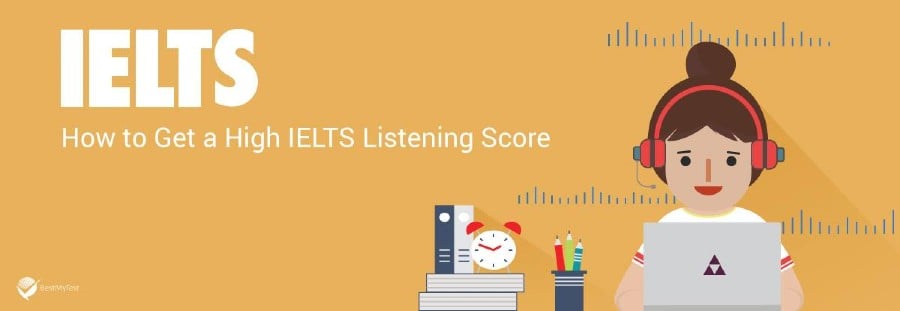
Free IELTS Listening Test: Prepare with over 125 IELTS Listening Practice Tests to Get a High IELTS Listening Band Score.
In this guide, you'll take a free IELTS listening test and get a full IELTS listening score analysis. You'll prepare with over 125 IELTS listening practice tests , lessons, tips, and video answer explanations. Following our personalized study plan, you'll achieve your target IELTS listening band score.
Get a free IELTS listening score analyses and personalized study plan after completing a free IELTS listening practice test.
Below is our full list of IELTS listening questions with answers. Note: The red links are our most popular and recommended listening questions rated by our students and you can practice them free anytime you like.
| (Form Completion / Matching) (Table Completion / Multiple Selection / Multiple Choice) (Multiple Choice / Sentence Completion) (Multiple Choice / Note Completion) (Multiple Choice / Form Completion / Short Answer) (Table Completion) (Multiple Choice / Sentence Completion / Multiple Selection) (Table Completion / Sentence Completion) (Form Completion / Multiple Selection / Short Answer) (Table Completion / Multiple Choice / Multiple Selection) (Table Completion / Short Answer) (Table Completion / Multiple Selection / Matching) (Table Completion) (Sentence Completion / Diagram Labelling) (Multiple Choice / Matching / Diagram Labelling) (Sentence Completion) (Form Completion) (Sentence Completion / Table Completion) (Multiple Choice / Note Completion / Multiple Selection) (Multiple Choice / Note Completion / Table Completion) (Multiple Choice / Note Completion / Short Answer) (Table Completion) (Multiple Choice / Multiple Selection / Note Completion) (Table Completion / Diagram Labelling) (Form Completion / Multiple Selection / Short Answer) (Table Completion / Multiple Choice / Multiple Selection) (Table Completion) (Table Completion) (Table Completion) (Sentence Completion / Multiple Choice) (Sentence Completion / Matching) (Sentence Completion) (Table Completion) (Table Completion) (Multiple Choice / Note Completion / Multiple Selection) (Multiple Choice / Note Completion) (Multiple Choice / Form Completion / Multiple Selection) (Table Completion) (Multiple Choice / Note Completion) (Table Completion / Sentence Completion) (Table Completion) (Note Completion) (Multiple Choice / Note Completion / Multiple Selection) (Multiple Choice / Note Completion) (Table Completion / Form Completion) (Multiple Choice / Matching) (Note Completion / Multiple Choice / Sentence Completion) (Note Completion / Sentence Completion) (Form Completion / Multiple Choice) (Short Answer / Multiple Choice / Matching) (Note Completion / Multiple Choice / Sentence Completion) (Note Completion / Sentence Completion) (Form Completion / Multiple Choice) (Sentence Completion / Matching) (Note Completion / Multiple Choice / Sentence Completion) (Note Completion / Sentence Completion) (Note Completion) (Note Completion) (Multiple Choice / Sentence Completion) (Multiple Choice / Sentence Completion) (Multiple Choice / Sentence Completion) (Table Completion) (Multiple Choice / Sentence Completion) (Note Completion) (Note Completion) (Table Completion) (Multiple Choice / Note Completion) (Multiple Choice / Note Completion) (Form Completion) (Note Completion / Matching) (Note Completion / Multiple Choice / Sentence Completion) (Note Completion / Table Completion) (Form Completion) (Multiple Selection / Multiple Choice / Table Completion) (Multiple Choice / Sentence Completion) (Note Completion / Table Completion) (Multiple Choice / Note Completion / Multiple Selection) (Diagram Labelling) (Multiple Choice / Table Completion) (Note Completion) (Note Completion) (Multiple Choice / Matching) (Table Completion) (Note Completion / Table Completion) (Form Completion / Multiple Selection / Short Answer) (Table Completion / Multiple Choice / Multiple Selection) (Table Completion) (Table Completion) (Table Completion) (Sentence Completion / Table Completion) (Multiple Choice / Note Completion / Multiple Selection) (Note Completion) (Table Completion) (Multiple Choice / Matching) (Note Completion) (Sentence Completion / Table Completion) (Table Completion) (Multiple Choice / Matching) (Note Completion) (Note Completion / Multiple Choice) (Multiple Choice / Form Completion / Multiple Selection) (Multiple Selection / Multiple Choice / Matching) (Multiple Choice / Note Completion) (Note Completion) (Table Completion / Diagram Labelling) (Table Completion / Diagram Labelling) (Note Completion / Diagram Labelling / Table Completion) (Multiple Choice / Diagram Labelling) (Multiple Choice / Diagram Labelling / Table Completion) (Multiple Choice / Diagram Labelling) (Table Completion / Multiple Choice) (Matching) (Sentence Completion) (Note Completion / Table Completion) (Diagram Labelling) (Form Completion) (Form Completion) (Multiple Selection / Multiple Choice / Matching) (Multiple Selection / Multiple Choice) (Multiple Choice / Note Completion) (Note Completion / Table Completion) (Multiple Choice / Matching) (Multiple Choice / Matching) (Note Completion) (Table Completion / Matching) (Multiple Choice / Matching) (Table Completion / Matching) (Note Completion) |
IELTS Listening Practice Test Guide
The remainder of this guide will teach you everything about the IELTS listening test. You'll learn about how the listening score is calculated, learn how to answer each listening question type successfully to improve your IELTS listening band score, and learn our tested 3-step process to help you study IELTS listening tests online.
Table Of Contents
Ielts listening test info, free ielts listening sample pdf download with answers.
- 6 IELTS Listening Task Types
3-steps for an Effective IELTS Listening Test Online Preparation
Ielts listening practice free resources.
The IELTS Listening Test is divided into 4 sections. In each section, you will listen to one or more native English speakers then answer around 10 questions related to what you just heard. The entire IELTS listening section contains 40 questions in total . In general, the listening recordings start off easier and get harder as you progress through the exam. Each recording is heard only once and includes a range of accents, including British, Australian, New Zealand, American, and Canadian.
- Section 1 – a conversation between two people set in an everyday social context. For example, you might hear a conversation about confirming details for a reservation, or placing an order over the phone.
- Section 2 - a monologue set in an everyday social context. For example, you might hear a speech about local facilities, or someone providing directions, or presenting basic information about an event.
- Section 3 – a conversation between up to four people set in an educational or training context. For example, you might hear a university tutor and a student discussing an assignment, or a couple of students discussing something from class.
- Section 4 - a monologue on an academic subject. For example, you will hear a university lecture from a professor. This is the toughest recording on the Listening exam for most students.
You can check out the IELTS official listening answer sheet pdf here or just look at the image below :)
At the end of the listening section, you are given 10 minutes to transfer answers from your Question Booklet to your Answer Sheet. IMPORTANT! Misspellings and incorrect grammar are marked INCORRECT , so use the 10 minutes to double check your spelling and Grammar.
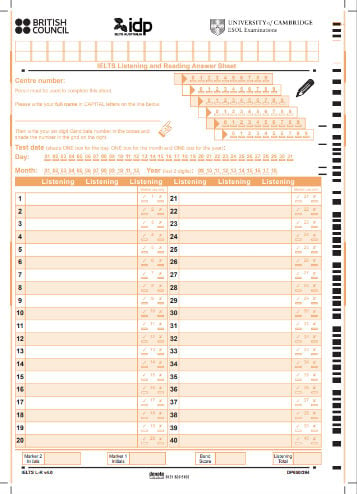
Calculating IELTS Listening Score
On the Listening section, each question is worth 1 point, so you can achieve a "raw" score of up to 40 points. Then, your raw score will be converted into your band score. Remember! You do not lose points for incorrect answers. The table below can give you a general idea about how raw scores are converted to band scores.
| Raw scores | Band scores |
|---|---|
| 39-40 | 9 |
| 37-38 | 8.5 |
| 35-36 | 8 |
| 32-34 | 7.5 |
| 30-31 | 7 |
| 26-29 | 6.5 |
| 23-25 | 6 |
| 18-22 | 5.5 |
| 16-17 | 5 |
| 13-15 | 4.5 |
| 11-12 | 4 |
Because each version of the IELTS is slightly different, the raw score required to achieve a certain band score differs depending on how everyone who took the test performed that day. Thus, the number of correct answers needed to get a band score will vary slightly from test to test, but in general you should be aiming to get around 30 out of 40 if you want to get a band score of 7.
As noted above, the sections get tougher and tougher as you progress through the IELTS listening test. However, every question is worth the same number of points. Therefore, make sure you're not losing out on easier points because you get stuck on hard questions.
Here are some free IELTS listening samples in PDF format with answers from the British Council (the makers of the IELTS exam). Try to answer the questions and see how you do!
- IELTS Listening Practice Test 1- questions (Online Examples)
- IELTS Listening Practice Test 1- answers (PDF)
- IELTS Listening Practice Test 1- answer sheet (PDF)

| Express train leaves at (1) | |
| Bus | (6) $ | $1.50 |
| Train (peak) | $10 | $10 |
| Train (off-peak) – before 5pm or after (7) | $10 | (8) $ |
| (9) | $4.50 | $3.55 |
| Tourist ferry ((10) | $35 | – |
| Tourist ferry (whole day) | $65 | – |
- spellcheck Answers 1. 9.30 (am) 2. Helendale 3. Central Street/St 4. (number/no./#) 792 5. 8.55 (am) 6. 1.80 7. 7.30 8. 7.15 9. commuter 10. afternoon

| Adjusting | what you need to succeed academically | (15) |
| Getting Organised | use time effectively, find (16) | all students |
| Communicating | talking with staff, communicating across cultures | all students, especially (17) |
| Anxiety | (18) | students about to sit exams |
| (19) | staying on track for long periods | (20) |
- spellcheck Answers 11. C 12. C 13. A 14. B 15. first/1st year 16. (right) balance 17. international/foreign (students) 18. relaxation 19. motivation 20. research/advanced
| Novel: (21) |
| Protagonists: Mary Lennox; Colin Craven |
| Time period: Early in (22) |
| Mary moves to UK – meets Colin who thinks he'll never be able to (23) |
| Point of view: “Omniscient�? – narrator knows all about characters' feelings, opinions and (24) |
| Audience: Good for children – story simple to follow |
| Symbols (physical items that represent (25) |
| Motifs (patterns in the story): |
| Themes: Connections between |
- spellcheck Answers 21. The Secret Garden 22. (the) 20th/twentieth century 23. walk 24. motivations/motivation 25. abstract ideas 26. roses 27. dark(ness) to light(ness) 28. health 29. environment 30. human companionship
| Past | Positive | Remember good times, e.g. birthdays. Keep family records, photo albums, etc. |
| (31) | Focus on disappointments, failures, bad decisions. | |
| Present | Hedonistic | Live for (32) |
| Fatalistic | Life is governed by (33) | |
| Future | (34) | Prefer work to play. Don't give in to temptation. |
| Fatalistic | Have a strong belief in life after death and importance of (35) | |
- A. at school
- B. at birth
- C. while eating and drinking
- A. they need to be in control of the way they learn
- B. they play video games instead of doing school work
- C. they are not as intelligent as girls
- A. do not realise present actions can have negative future effects
- B. are unable to learn lessons from past mistakes
- C. know what could happen if they do something bad, but do it anyway
- A. working harder
- B. building relationships
- C. sharing family meals
- A become more virtuous
- B work together better
- C identify careless or ambitious people
- spellcheck Answers 31. negative 32. pleasure 33. poverty 34. active 35. success 36. B 37. A 38. C 39. A 40. B
How did you do answering the IELTS listening sample questions above? Did you find any of the questions difficult? If you did, it could benefit you to take a closer look at all 6 IELTS listening task types . The better you understand a task type, the less effort you'll need figuring out what you need to do and the more time you'll have to figure out the answer.
The 6 IELTS Listening Task Types
There are 6 different types of questions on the IELTS listening test. It is important you practice each task type to learn the best way to tackle each one for a high IELTS listening score. In the following sections, you'll learn about all 6 IELTS listening task types and try a sample question for each one.
Before we talk about each task type in detail, let's look at a 2017 trend for IELTS listening question types. The pie charts below illustrate the proportion of each listening task type that appeared in official IELTS listening tests in 2017.
IELTS Listening Task Types - Sections 1 & 2
Overall, the "Form/Note/Table/Flow-Chart/Summary Completion" type of question remain the most popular question type in section 1, whereas 4 question types ("Matching", "Multiple choice", "Plan/Map/Diagram labelling", and "Form/Note/Table/Flow-Chart/Summary Completion") appeared relatively equally in section 2.

| Question (Task) Type | Percentage |
|---|---|
| Form/Note/Summary/Sentence Completion | 86 |
| Multiple Choice | 8 |
| Matching | 6 |

| Question (Task) Type | Percentage |
|---|---|
| Form/Note/Summary/Sentence Completion | 29 |
| Multiple Choice | 36 |
| Matching | 20 |
| Plan/Map/Diagram labelling | 15 |
IELTS Listening Task Types - Sections 3 & 4
In section 3, "Multiple Choice" question type was the most common at 36%, with "Form / Note / Summary / Sentence Completion" question type a close second with 34%. Finally, "Matching" question type accounted for 22% and other question types accounted for 8%.
In section 4, "Form / Note / Summary / Sentence Completion" question type predominates with 66%, and other question types combined for 34% in total.

| Question (Task) Type | Percentage |
|---|---|
| Form/Note/Summary/Sentence Completion | 34 |
| Multiple Choice | 36 |
| Matching | 22 |
| Others | 6 |

| Question (Task) Type | Percentage |
|---|---|
| Form/Note/Summary/Sentence Completion | 66 |
| Multiple Choice | 12 |
| Short Answer | 8 |
| Matching | 5 |
| Plan/Map/Diagram labelling | 4 |
| Flow Chart Completion | 5 |
Although each listening question type looks different, the basic approach to each one is the same. Later on in this post, we'll show you the basic strategy to tackle all 6 question types. Now let's look at each task type in detail.
Task Type 1 – Sentence Completion
Task type 2 – matching, task type 3 – plan, map, diagram labelling.
- Task Type 4 – Form, Note, Table, Flow-Chart, Summary Completion
- Task Type 5 – Multiple Choice
- Task Type 6 – Short Answer Questions
This task type requires you to complete a sentence with a short answer. The sentence will almost always be a paraphrase of something you'll hear in the passage. In other words, don't expect to hear a speaker say the exact sentence as it's written in the question. You must read the instructions very carefully. For example, if the instruction says NO MORE THAN TWO WORDS , you will be penalised for writing more than TWO words. The answer can be one word, but will never be more than two.

| 27 | |
| 28 | |
| 29 | |
| 30 |
- spellcheck Answers 27 motivation 28 time(-)management 29 modules 30 summer school(s)
In a matching task, you are required to match a numbered list of items from the listening text to a set of options on the question paper. This task requires you to listen for detailed information and recognise relationships and connections between facts in the listening text. For example, you need to identify the different types of hotels or guest house accommodations. It is important to analyze these questions before listening to the passage so that you understand the category of the lettered answer choices.

| 21 | |
| 22 | |
| 23 | |
| 24 | |
| 25 |
- spellcheck Answers 21. C 22. A 23. B 24. B 25. C
In this task type, you are required to complete labels on a plan (eg of a building), map (eg of part of a town) or diagram (e.g. of a piece of equipment). The answers are usually selected from a list on the question paper. This task type appears in all sections, but mostly in section 2. In section 2, you will listen to one speaker talking about common daily situation. For example, You might have to listen to the speaker giving a tour or describing a proposed site to investors.

| 11 | |
| 12 | |
| 13 | |
| 14 | |
| 15 |
- spellcheck Answers 11. H 12. G 13. D 14. B 15. F
Task Type 4 – Form, Note, aTble, Flow-chart, Summary Completion
In this task type, you will be given a form, a set of notes, a table, a summary, or a flow-chart and you will need to fill in the missing information based on the listening passage. You may have to select their answers from a list on the question paper or identify the missing words from the recording, making sure to keep to the word limit stated in the instructions .
- a form : a form question is a common task type for section 1. You will fill out a form like an application, booking, or an order form. Often it will be a phone conversation between two people. One person will either be, ordering, booking or requesting information about something, while the other person is helping them.
- a set of notes : A Note question is a common task type for section 4. You will hear a university lecture and then be given incomplete lecture notes. You'll need to fill in the missing points based on the lecture.
- a table : A Table question is often used to categorize many things such as place, time, and price. You will need to fill in the missing information from the table.
- a flow-chart : A flow chart can show a process, plan or sequence of past events. You will need to complete the chart with either, words from the recording, or by choosing one of the options from a lettered list.
- a summary : In a summary question, you will be presented with a paragraph, which summarizes the listening passage, and you'll need to fill in the words to complete the summary based on what you hear.
You must read the instructions very carefully. For example, if the instruction says ‘NO MORE THAN TWO WORDS', you will be penalised for writing more than two words.

| 1 | |
| 2 | |
| 3 | |
| 4 | |
| 5 | |
| 6 | |
| 7 | |
| 8 |
- spellcheck Answers 1. Mkere 2. Westall 3. BS8 9PU 4. 0.75 m/metre(s)/meter(s) (wide) / three(-)quarter(s) (of) (a) metre/meter (wide) / ¾ m (wide) / 75 cm(s) (wide) 5. 0.5 m/metre(s)/meter(s) (high/deep) / (a) half (a) metre/meter (high/deep) / ½ m (high/deep) / 50 cm(s) (high/deep) 6. & 7 in either order (some) books (some) toys 8. 1,700
Task Type 5 – Multiple choice
In a multiple choice task, there is a question followed by three possible answers, or the beginning of a sentence followed by three possible ways to complete the sentence. You must answer with LETTERS (A, B, or C) on your Answer Sheet. Don't write the answer choice word(s! Sometimes you are given a longer list of possible answers and told to choose more than one. In this case, you should read the question carefully and check how many answers are required.

| 9 | |
| 10 |
- spellcheck Answers 9. C 10. A
Task Type 6 – Short Answers
Short answer questions require you to read a question and then write a short answer using information from the listening text. You will probably be given a limit, for example, 'No more than two words'. If you write more words than the instructions tell you to, your answer will be marked as incorrect. Very often, you will have to find detailed information related to some category. For example, you might get a question like this: What TWO factors can make social contact in a foreign country difficult?

- 11 ....................
- 12 ....................
- 13 ....................
- 14 ....................
- 15 ....................
- 16 ....................
| 11 | |
| 12 | |
| 13 | |
| 14 | |
| 15 | |
| 16 |
- spellcheck Answers 11 & 12: (in either order) language, customs 13 & 14: (in either order) music, local history 15 & 16: (in either order) library/libraries, town hall
Although each IELTS listening question (task) type is different, the basic approach to each one is the same. You can tackle all task types by using one simple, step-by-step strategy. Here are the three steps that we recommend you use to approach Listening question types:
- Examine questions closely to find key information
- Predict potential answers before listening
- Follow along to match questions with content as they listen
Step 1: Examine Questions
On the IELTS Listening section, you'll be given a brief preparation time (30-40 seconds) before the recording starts. This is your opportunity to take a look at the questions you'll need to answer, which is exactly what the first step in this strategy is all about. Rather than use this time to take a break, or to check your answers, you will focus on learning as much as you possibly can about the questions ahead. Taking this step is important to avoid the mistake of multitasking while listening to the speaker and trying to read the questions for the first time.
When your preparation time begins, first make the best possible use of this time by examining the questions to find out more about them. These are some of the pieces of information you should be looking for when examining each of the IELTS Listening questions:
- What kind of a question is this?
- What will the answer look like? (example: a date, a number, a name)
- What are the most important phrases and words, or keywords, in the questions?
One example could be a Note Completion question type, like this:
First, you can underline some of the keywords in the question. Two reasons for the new approach to pricing are changes in (27) ______ and (28) _________ programs . In this example, listening for the key phrase " two reasons " that you had already underlined allows you to begin paying close attention at the right moment. Here is the part of the audio script that reveals the answer:
After having examined the questions, you would know that " the law " and " computer " were the correct response here based on some keywords and knowing the question type.
Step 2: Predict Potential Answers
The second step in this strategy to succeed on the IELTS Listening section is very closely related to the first. In fact, you should attempt to complete both of these steps within the same 20 second preparation time before the recording starts. While this may seem like a difficult task to do in such a short amount of time, remember that these steps are actually linked to one another.
To predict potential answers to the Listening questions, you will first need to have completed step one by examining the questions closely. At this point, you should know what kind of question you are looking at, what potential answers will look like, as well as which keywords will be of assistance in locating the answers quickly. To predict answers, you will combine all of this information and make a guess about what kind of answer you expect to hear.
Let's revisit the same Note Completion example question from above. Two reasons for the new approach to pricing are changes in (27) and (28) programs.
Just by looking at the grammar of this sentence allows you to identify what part of speech the answer will be. In this case, the preposition "in" precedes both of the potential answers. Grammatically, only nouns or noun phrases can be used this way in prepositional phrases. Not only can you predict, correctly, that the answer will be a noun or noun phrase, but it would also be possible to predict that the answer could be something related to policy or government (law), and a word that can appear with programs (computer) based on context.
Although it's impossible to guess the exact correct answer based on predictions alone, by making an attempt to imagine what the answer might be, you are more likely to listen for relevant information while ignoring irrelevant information. Predicting potential answers before the recording begins will prepare your ear, getting you one step closer to the correct answer.
Now, try putting Step 1 (examine questions) and Step 2 (predict potential answers) together in a more difficult multiple choice example question.
- are for weekend shows
- are booked well in advance
- are non-refundable
- are booked for groups
Although there isn't a way to know the answers to these questions for sure, you can still use the information found in these questions to predict potential answers and target your listening. For example, question 24 concerns the reason why theatre ticket prices will be the lowest, so you will want to listen closely for any of those reasons mentioned . Bear in mind, it's possible that more than one will be mentioned. Take a look at the script below to see how prediction can help you eliminate wrong answers.
Notice how three of the potential answers are mentioned, "booked for groups", "are for weekend shows" and "are non-refundable." However, the correct answer is C "are non-refundable" because it is mentioned as cheaper separately from the other two, which are simply listed together.
Step 3: Follow Along
Once the recording starts and the actual listening part of the test begins, you should follow along to complete step three of this IELTS Listening section strategy. Following along requires you to focus closely on what you are hearing, while at the same time keeping track of which question the content may be addressing.
The questions on the IELTS Listening exam section will usually appear in order of where their answers can be found in the content of the recording. This gives you an advantage in the test, because it means that once you have heard the answer to one question, you will immediately turn your attention to the next one in order. If you are able to follow along successfully by matching the context from the questions to what you are hearing in the recording, you will stay on track and avoid missing key information necessary to answer each of the questions.
Doing this is easier said than done, however. You will need to multitask by listening while simultaneously keeping your eye on the next question. If you do, in fact, miss the answer to a question, you will know when you hear the answer to a later one. Even though this can be confusing and even frustrating, missing one answer and being aware of it is still preferable to getting completely lost in the content and missing even more of the answers. In the scenario of missing a question, you should simply leave it, and continue onto the next one. At the end, you will have to make your best guess about the question you missed. However, on the bright side, it's possible that listening to the recording in its entirety may provide you with other contextual clues and allow you to answer any questions you missed more accurately.
You'll need strong listening skills to get a high band IELTS listening score. Because of this, it's important you train consistently every day until test day.
Below are some resources you can use to train and maintain your listening skills daily.
- YouTube - https://www.youtube.com
- BBC Learning English - http://www.bbc.co.uk/learningenglish
- TED - https://www.ted.com/
- BBC radio - https://www.bbc.co.uk/worldserviceradio
- ABC news in Australia - https://radio.abc.net.au/stations/news/live?play=true
IELTS Practice Tests
- IELTS Listening Test
- IELTS Reading Test
- IELTS Writing Task 1 & 2
- IELTS Speaking Test
All information on this page was referenced from the official IELTS website: www.ielts.org
Try IELTS Tutor for 7 days with no commitment
Start learning today, sign up free.
Just enter your email & password below.
Free IELTS lessons signup

- Academic practice
- General practice
- Task 1 Academic
- Task 1 General
- Task 2 (essay)
IELTS Listening Sample 10. Section 4
This is the last section of IELTS Listening practice test #10 . Listen to the audio and answer the questions. After you finish, click 'check' and 'get result!' to see your score for the whole test.
SECTION 4. QUESTIONS 31-40
Complete the notes below.
Write NO MORE THAN THREE WORDS for each answer.
|

Each question correctly answered scores 1 mark. Correct spelling is needed in all answers.
- Well-organised
- Paying attention
- Sheet of paper
- Entire/Full

Recent posts
- IELTS Speaking Part 2 Topics: Gift
- IELTS Speaking Part 2 Topics: Birthday
- IELTS Speaking Part 2 Topics: Family
- IELTS Speaking Part 2 Topics: Movie
- IELTS Speaking Part 2 Topics: Book
- Link copied!
Free IELTS Listening Practice Test
We have prepared a full IELTS Listening practice test (same as the real exam) with an audio player, answers and audio transcript that you can take for free to test your listening skills.
Use the following steps to complete your IELTS Listening test:
- Grab a pencil and paper
- Start the audio player (tracks play automatically)
- Complete the test within 40 minutes (30 minutes for listening and 10 minutes for transferring your answers to your answer sheet)
- Check your answers and find out your listening score (see the listening test answers and listening score at the end of the page)

You may also want to see:
- IELTS Listening Test Format, Tips & Preparation Advice
While you practice, we recommend that you do that under the exam conditions, strictly following the rules.
Note! The following IELTS Listening practice test has been provided by IELTS.org and extracted from public pdf files.
IELTS Listening Practice Test
Questions 1–4
Complete the table below.
Write NO MORE THAN TWO WORDS AND/OR A NUMBER for each answer.
City Bank Customer Service Log
Customer's Term Deposit details:
Current Term Deposit interest rates:
4 Term Deposits
Minimum deposit: $20,000
Questions 5–10
| 5 tax rate: | 28% | |
| Investment returns | Depend on 6 | |
| Term | Effective rate of return | |
| 2 years | Salary $48,001 – $70,000
3.75% per annum | Salary $70,001 – 7 $ 3.92% per annum |
| Minimum investment amount: | $10,000 | |
| Hidden charges/fees: | 8 | |
| Interest payment options: | monthly, 9, 6‑monthly, annually | |
| Application options: | online 10 in person | |
Questions 11–15
Choose the correct letter, A, B or C.
11 The September Celebration day is held
A five times a year to honour the city
B on the park’s important birthday
C to remember the history of the park
12 The park was first built in
C the 1990s
13 The park still uses
A a children’s play area
B a petting zoo
C two of the early rides
14 The Hurricane roller-coaster is
A tall and made of wood
B designed for smaller children
C very fast and exciting
15 The rides with a height limit are coded
Questions 16–20
Complete the notes below.
Write NO MORE THAN TWO WORDS for each answer.
Food options:
- Italian, Chinese, etc. at the Food Court
- hamburgers, sandwiches, etc. at 16
Special events:
- Starts at noon
- Run by final year high school students
- At the amphitheatre
- Starts at 7:00
Safety and Security:
- Ten 19 centres in the park
- Children ask any staff member for help
- Ask security team at the 20
Questions 21–24
Complete the flowchart below.
Session outline:
Project topic: design a water treatment system
Tutorial structure:
Step 1: go over 21
Step 2: think about research 22
- search online databases using good search terms
- consider the kind of research, e.g. 23 from other projects
Step 3: develop an 24
Questions 25–27
Complete the summary below.
Write NO MORE THAN ONE WORD for each answer.
Project description:
You need to design a grey-water treatment system to reduce the pressure on the water 25 in a Cameroon village. Grey-water is wastewater from household 26 . The system needs to treat this water to remove bacteria, and recycle it to use for purposes such as watering plants, flushing toilets and doing 27 .
Questions 28–30
Research tips
General internet searches:
Avoid websites where 28 try to sell their products.
Engineering library:
Use key words when searching the catalogue e.g. grey-water treatment systems / 29 use
EWB website
Check examples from the 30 last year.
Questions 31–34
Origins of the Caveman Diet
There are many popular fad diets nowadays. They all promise good health if you stick to the 31 . The Caveman diet is a popular example. This diet includes foods such as lean meat and fish that our forebears ate before we developed 32 . We need to find out what our ancestors did eat, so researchers are studying some existing hunter-gatherer tribes. These tribes typically like to eat meat but they can’t always get it, even though they are skilled with their weapons, e.g. 33 and . So, instead, they eat foods that their wives gather. They get only about a 34 of their energy from meat.
Questions 35–36
35 Research evidence suggests that
A the tribesmen’s traditional diet is unhealthy
B our bodies can digest only certain foods
C we can adapt to a range of diets.
36 Thai people have difficulty digesting milk because
A they have too much lactase in their bodies
B in the past they didn’t farm cows
C their saliva lacks certain enzymes.
Questions 37–40
Variation in global diets:
- Inuit – most calories from 37 foods, e.g. seal meat
- Jains – vegetarian, but milk is permitted
- Others – fish, insects
Implications for the caveman diet:
- Cavemen did not all eat the same diet
- Diets come from complicated cultural 38
Problems with Caveman diet:
- Costs a lot of money for lean meat and 39
- Too much red meat may be unhealthy
- Reliance on meat is bad for the 40
Listening Answer Key
- Monthly Interest / monthly interest
- income bracket
- 120,000 / 120000
- food stands
- Main Street / St. / main street / st.
- first-aid / first aid / First Aid
- guard stations
- task instructions
- case studies
- action plan
- manufacturers
- residential
- competition
- agriculture
- bows, arrows [in either order]
- third / 3rd
- high fat / high-fat
- (dietary) practices
- environment
IELTS Listening Score
| Band Score | Raw score out of 40 |
| 9 | 39–40 |
| 8.5 | 37–38 |
| 8 | 35–36 |
| 7.5 | 32–34 |
| 7 | 30–31 |
| 6.5 | 26–29 |
| 6 | 23–25 |
| 5.5 | 18–22 |
| 5 | 16–17 |
| 4.5 | 13–15 |
| 4 | 11–12 |
| 3.5 | 8–10 |
| 3 | 6–7 |
| 2.5 | 4–5 |
We are here to help
Whether you have any questions, want to leave feedback or discuss cooperation possibilities, do not hesitate to contact us. We are here to help and will answer as soon as possible. In the meantime, discover our site and let it help you smooth your IELTS journey and make your studies more efficient.
You will find useful information on all the four IELTS test components:
Got a question? We'd love to hear from you!

Shopping Cart
Mastering the ielts listening section.
You’re preparing to take the IELTS listening section, and you want to do your best.
But there’s one thing you’re not sure about: what the test is like. It can be tricky to know what to expect, especially since the listening section is completely audio-based. In this post, we’ll give you a little taste of what to expect on test day.
You’ll learn about the different types of questions that appear on the IELTS listening section, as well as some tips for how to approach them. We’ll also show you a sample question and answer so you can get a feel for the format of the test. Let’s get started!
What Is the IELTS Listening Section?
- The first two components of the exam address social demands.
- The following two parts deal with circumstances that are more directly tied to educational or training environments.
- All of the IELTS listening themes are of broad interest, regardless of what disciplines you intend to study or what profession you aim to pursue.
- A range of English accents and dialects are used in the recordings which reflects the international usage of IELTS
Lets Understand About Each Section In IELTS Listening
There is a dialogue between two speakers in the first segment. For example, a discussion regarding trip plans, reserving accommodations, or enquiry
The second part is a monologue (a speech by one person). It will be situated in a typical social setting. A lecture on student services on a university campus, for example, or dining arrangements during a conference.
The third part is a dialogue between up to four persons. A talk between a tutor and a student concerning an assignment, for example, or between three students organising a research project.
The final section is a monologue. It is a general academic lecture or talk, such as a university lecture
The IELTS Listening Section is a crucial part of the test. This is the section where you listen to audio recordings and answer questions based on what you hear. It’s important to prepare for this section so that you can do your best on test day.
There are a few things you can do to prepare for the IELTS Listening Section. First, make sure you’re aware of the format of the test. The questions will be based on four different recordings, so make sure you know what to expect.
Also, practice listening to English audio recordings. This will help you get used to the sound of English and the accent of the speakers. And lastly, review the types of questions that will be asked in the IELTS Listening Section. Knowing what to expect will help you stay calm and focused on the task at hand.
IELTS Listening Tips and Tricks
So you’re taking the IELTS exam and you’re feeling a little bit nervous about the listening section? don’t worry, you’re not alone.
The good news is that there are a few tips and tricks that can help you ace this section of the test.
- First, it’s important to understand the types of questions that will be asked. There are four main question types: multiple choice, short answer, sentence completion, and table completion. Familiarize yourself with the types of questions and what the answers might look like.
- Next, practice, practice, practice! The more you listen to English, the better you’ll be able to understand it when it’s played back to you in a test setting. Try to find audio files that are relevant to your interests—news broadcasts, podcasts, interviews, etc.—and listen to them regularly.
- Finally, stay calm and focus on the task at hand. Listen closely to each question and make sure you understand what’s being asked before you begin answering. If you get stuck on a question, don’t panic—there’s no time limit, so take your time and try to answer as best as you can.
IELTS Listening Common Mistakes
It’s important to be aware of the most common mistakes people make in the IELTS Listening section, because these can really hurt your score. Here are some of the most common ones:
Not paying attention to the question: Make sure you read the question carefully and understand what is being asked before you start listening.
Not listening carefully: This is a big one – make sure you listen to every word to get all the information you need.
Not using proper format to transfer the answer – While transferring the answer use clear handwriting. it is preferred to use capital letters and using proper space where required. You should how words are counted in Listening test
Not Reading the instructions – It is important to read instructions to be aware about the word limit.
Answering the question without listening: This happens when you hear the answer to a question and just start writing without actually listening to the audio. Make sure you wait until you’ve heard all the audio before writing your answer.
Not writing everything down: It’s very important to write everything down, as there will be questions later based on information in the audio.
Not transferring answers onto the answer sheet: This is another common mistake – make sure you copy your answers onto the answer sheet correctly.
If you can avoid making these mistakes, you’ll be well on your way to achieving a great score in the IELTS Listening section!
IELTS Listening Practice
It’s no secret that the IELTS Listening section can be tricky. But with a little practice, you can master it. Start by listening to the recordings a few times. Pay attention to the details and try to anticipate what’s going to happen. Then, answer the questions as quickly as you can. Don’t spend too much time on one question—just focus on getting the answer right.
Finally, don’t forget to practice vocabulary and idioms that are commonly used in the IELTS test. This will help you understand the questions and answers better. With a little bit of practice, you’ll be able to ace the IELTS Listening section!
IELTS Listening Score Calculator
So how can you figure out your IELTS listening score?
Well, there’s a handy band descriptor will do the job for you. Just check in your test score and it will give you an estimate of your band score. Pretty nifty, huh?
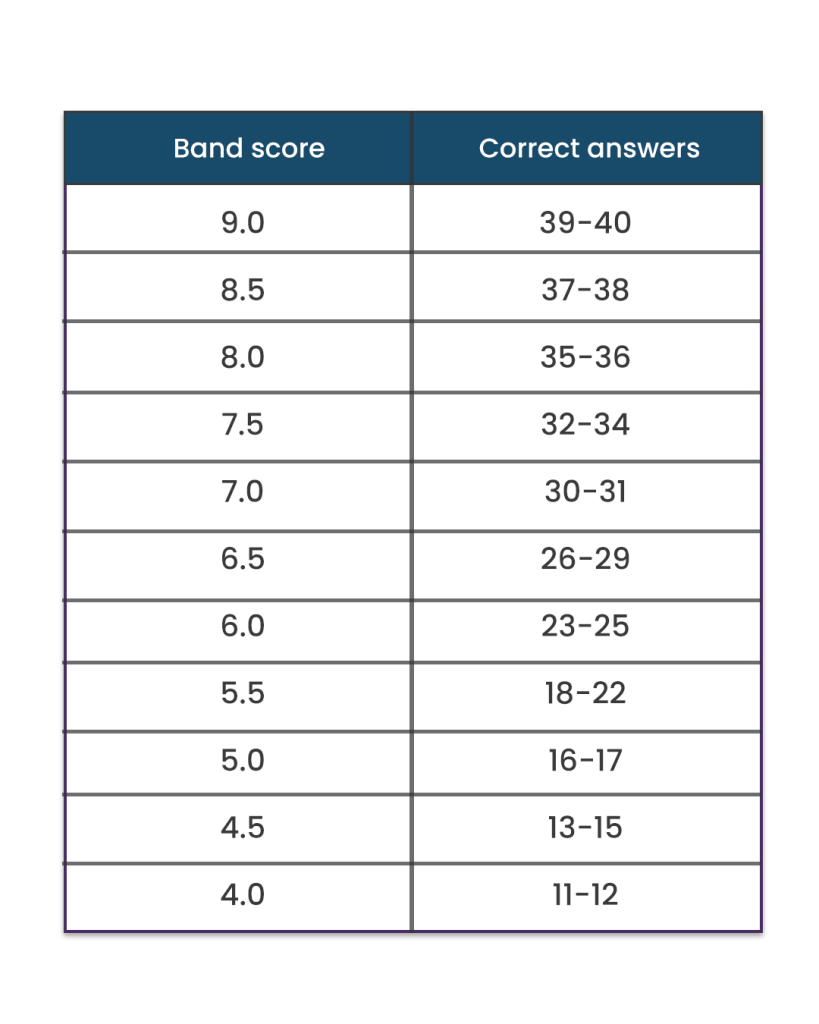
This Listening score chart can help you keep track of your progress.
Question Types
The following types of question may appear on the test:
- Multiple choices
- Short Answers
- Classifications
- Flow chart/ Table/summary completion
- Diagram labelling
IELTS Listening Tips for Specific Sections
In the IELTS listening section, you’ll be asked to listen to a variety of different types of audio content. This might be a conversation between two people, a lecture, or a presentation.
To score well in this section, you’ll need to be able to understand the main points of the audio and answer the questions accurately. Here are a few tips to help you master the IELTS listening section:
- Listen carefully and don’t worry if you don’t understand everything at first. The questions will help you focus on the most important information.
- Try to anticipate what might be asked based on the question stem. This will help you save time when answering the questions.
- Pay attention to the details in the audio and make sure your answers are correct.
You can pass the IELTS listening section with flying colors by following a few simple tips. Be sure to familiarize yourself with the type of questions you’ll be asked, and practice as much as possible. Stay calm and focused, and read the questions carefully. With a little preparation, you can easily score high on the IELTS listening section. Good luck!
[carousel_slide id=’16536′]
Related Articles

Things to Keep in Mind Before Taking the IELTS Listening Test.
IELTS Listening Test is the first module of the test, students get during the exam. In this section, the examiner plays a few audio recordings.…

IELTS Listening Master Program: Book a Free Training Session
IELTS Listening Master Program: In an IELTS Listening test, you would have to listen to a few audio recordings played by the examiner and answer…
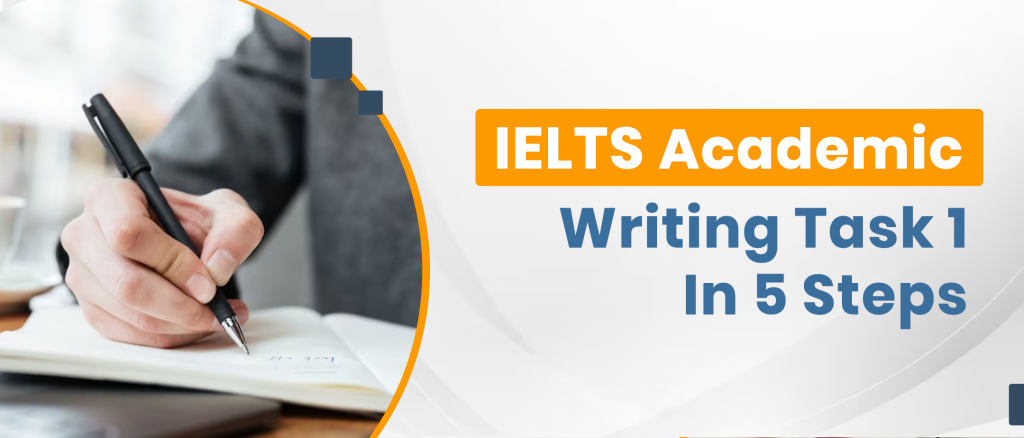
IELTS Academic Writing Task 1 In 5 Steps
Writing Task 1 You must write 150 words for Academic Writing Task 1 of the IELTS about a process, a map, or data presented in…

How to prepare for the IELTS exam?
Why is IELTS exam , unlike other tests, the only exam accepted by more than 10000 universities to check English language proficiency? There are other…
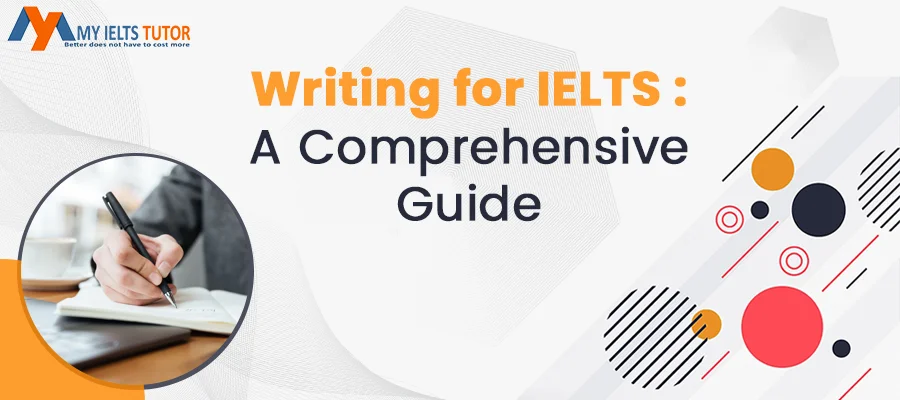
Writing for IELTS: A Comprehensive Guide
In this comprehensive guide, we’ll go over all aspects of the IELTS writing test. We’ll discuss the different types of essays you’ll be asked to…
- +91 92892 09996
- +91 92892 06669
- [email protected]
- 657, Dugri Rd, near Reliance Petrol Pump, Sant Fateh Singh Nagar, D-Block, Model Town Extension, Model Town, Ludhiana, Punjab 141002
Powered by North Pole Edutech Private Limited
Forum description.
You're preparing to take the IELTS listening section, and you want to do your best.
But there's one thing you're not sure about: what the test is like. It can be tricky to know what to expect, especially since the listening section is completely audio-based. In this post, we'll give you a little taste of what to expect on test day.
You'll learn about the different types of questions that appear on the IELTS listening section, as well as some tips for how to approach them. We'll also show you a sample question and answer so you can get a feel for the format of the test. Let's get started!
The IELTS Listening Section is a crucial part of the test. This is the section where you listen to audio recordings and answer questions based on what you hear. It's important to prepare for this section so that you can do your best on test day.
There are a few things you can do to prepare for the IELTS Listening Section. First, make sure you're aware of the format of the test. The questions will be based on four different recordings, so make sure you know what to expect.
So you're taking the IELTS exam and you're feeling a little bit nervous about the listening section? don't worry, you're not alone.
- First, it's important to understand the types of questions that will be asked. There are four main question types: multiple choice, short answer, sentence completion, and table completion. Familiarize yourself with the types of questions and what the answers might look like.
- Next, practice, practice, practice! The more you listen to English, the better you'll be able to understand it when it's played back to you in a test setting. Try to find audio files that are relevant to your interests—news broadcasts, podcasts, interviews, etc.—and listen to them regularly.
- Finally, stay calm and focus on the task at hand. Listen closely to each question and make sure you understand what's being asked before you begin answering. If you get stuck on a question, don't panic—there's no time limit, so take your time and try to answer as best as you can.
It's important to be aware of the most common mistakes people make in the IELTS Listening section, because these can really hurt your score. Here are some of the most common ones:
Not using proper format to transfer the answer - While transferring the answer use clear handwriting. it is preferred to use capital letters and using proper space where required. You should how words are counted in Listening test
Not Reading the instructions - It is important to read instructions to be aware about the word limit.
Answering the question without listening: This happens when you hear the answer to a question and just start writing without actually listening to the audio. Make sure you wait until you've heard all the audio before writing your answer.
Not writing everything down: It's very important to write everything down, as there will be questions later based on information in the audio.
If you can avoid making these mistakes, you'll be well on your way to achieving a great score in the IELTS Listening section!
It's no secret that the IELTS Listening section can be tricky. But with a little practice, you can master it. Start by listening to the recordings a few times. Pay attention to the details and try to anticipate what's going to happen. Then, answer the questions as quickly as you can. Don't spend too much time on one question—just focus on getting the answer right.
Finally, don't forget to practice vocabulary and idioms that are commonly used in the IELTS test. This will help you understand the questions and answers better. With a little bit of practice, you'll be able to ace the IELTS Listening section!
Well, there's a handy band descriptor will do the job for you. Just check in your test score and it will give you an estimate of your band score. Pretty nifty, huh?
In the IELTS listening section, you'll be asked to listen to a variety of different types of audio content. This might be a conversation between two people, a lecture, or a presentation.
To score well in this section, you'll need to be able to understand the main points of the audio and answer the questions accurately. Here are a few tips to help you master the IELTS listening section:
- Listen carefully and don't worry if you don't understand everything at first. The questions will help you focus on the most important information.
You can pass the IELTS listening section with flying colors by following a few simple tips. Be sure to familiarize yourself with the type of questions you'll be asked, and practice as much as possible. Stay calm and focused, and read the questions carefully. With a little preparation, you can easily score high on the IELTS listening section. Good luck!
There was a problem reporting this post.
Block Member?
Please confirm you want to block this member.
You will no longer be able to:
- See blocked member's posts
- Mention this member in posts
- Invite this member to groups
Please allow a few minutes for this process to complete.
Learn IELTS 8 Band strategies Just at 299/-
Book your free 1:1 demo.
- A Beginner’s Guide to IELTS
- Common Grammar Mistakes [for IELTS Writing Candidates]
Writing Correction Service
- Free IELTS Resources
- Practice Speaking Test
Select Page
A Complete Guide to the IELTS Listening Exam
Listening is one of the four parts of the IELTS exam and it is the same regardless of whether you choose to take the academic or general test. It is comprised of four sections and you will be asked a variety of questions on these listening passages. You can expect to hear different accents and different types of materials, from phone conversations to lectures. There are forty questions and you have forty minutes to listen and answer. In this article, I will give a complete guide to the IELTS listening exam. You can find useful hints and tips for IELTS listening elsewhere on this site.
An Overview
The IELTS listening exam is the same for both the general and academic IELTS tests. It requires no specialist knowledge in order to pass, and is a good test of your overall English ability. Sections one and two are in a social context but the third and fourth sections are usually located in an educational facility, and have an academic context. I shall explain more about this, in detail, later.
The purpose of the IELTS listening exam is to test your ability to do the following:
- understand main ideas
- follow logical arguments
- find specific information (ie numbers, addresses)
- recognize opinions or attitudes
Importantly, you will only have one chance to hear the recording and choose a correct answer.
You will listen to approximately thirty minutes of recordings, including time for reading the questions. The instructions are clear, and you will be told “you now have x minutes” to check your answers or read the next set of questions. At the end of this time, you have ten minutes to transfer your answers from the question paper to the answer paper, which looks like this:
You will be given some time to read the questions prior to actually listening to the recording. You should note your answers on the question paper, and then transfer them during the final ten minutes to the answer sheet. Copy the answers carefully, paying attention to spelling. Make sure that you enter the right answer for the right question number.
Hint: Use your time wisely. When you are given time before a new section starts, don’t check answers from the previous section. Instead, read ahead and predict the sort of material you will hear next. For example, if there is a $ before the blank space, you will be listening for a number. Think about themes and content, as well as the specific answers you should listen for. You can use the time at the end to check spelling and review your answers.
There are four sections to the exam, and each is little more difficult than the one before it. This means that the first section is the easiest and the last is the most difficult. In this regard, it is the same as the speaking exam . There are ten questions in each section, making forty questions in total.
The first thing that you will hear is a set of instructions and an example answer, which is also marked on your question paper. After that, you will soon begin section one.
In this section, you will hear a conversation between two people. The situation will be a normal, everyday social setting. For example, a phone call to a travel agency or realtor. You are typically expected to listen for specific details like the person’s name, address, and phone number. It may look like this:
The British Council (who run the IELTS exam along with Cambridge University) offer free practice tests like this one . You can practice your listening skills here, or buy the official exam papers .
Next is a monologue, which means just one person speaks. This is again a social setting and typical examples include someone giving details about services, arrangements, or facilities. It will be something of general interest. You can expect different types of questions, and one very common question type in section 2 is filling in a table with the correct information.
Now we begin the academic half of the listening exam. In section 3, you will hear a conversation between two or more people talking about something related to education – maybe a college assignment or a post-lecture discussion. There can be up to four people talking, and you will most likely have to track their attitudes and opinions. You should also be aware that you may need to record factual information as well.
Here is an example question:
The final section is the most difficult one, and is a monologue set in an academic context. It will be related to section 3 and may consist of a lecturer or other speaker giving an informative talk on a set topic. You will not need to know anything about the topic in advance in order to get the questions right. You will, however, need to gather factual information and identify attitudes and opinions .
Here is a practice test that only looks at section 4 of the IELTS listening exam:
Video Overview
I made this video to help you better understand the IELTS listening exam as a whole. It should be very helpful for students who haven’t yet taken the IELTS, and just want to get a basic understanding.
Question Types
You will have noticed from reading the above guide that the IELTS listening exam, although difficult, is actually quite predictable. It is easy to prepare for it because it doesn’t change much. Thankfully, there are only a limited number of question types, too. Some of these are similar to the questions you are asked in the reading exam, while others are specific to the IELTS listening. I will look at some of the more common ones.
Multiple Choice
This is a very common question type, so you really should practice it often. In this type of question, you will be given several possible answers. You may be given a simple question or else the first part of a sentence. It is also possible that you may have to choose more than one answer, so read the instructions very carefully.
Here’s an example question:
What is John going to do before the course starts? A. attend a class B. write a report C. read a book
Hint: If you don’t know what the answer is, think about what is not correct. If are certain that C is incorrect, then you can guess at either A and B. Never leave a question unanswered.
Label a Map, Diagram, etc
One of the more challenging questions in the listening exam is labeling a map, diagram, or plan. In this case, you need to listen very carefully and follow the verbal description well enough to associate it with the visual representation. This requires the ability to follow instructions and directions, or determine spatial relationships.
It should look something like this:
Form, Table, Summary Completion
There are many variations on this, but quite simply you will be given some sort of incomplete information and asked to complete it according to the information in the listening passage. Perhaps it will be a note or form that needs to be filled with names or numbers. In other cases it is a more complex flow chart that needs you to listen for stages in a procedure.
The most important thing with this type of question is to read the instructions carefully. It will say something like:
WRITE NO MORE THAN TWO WORDS AND/OR A NUMBER
You must make sure to stick to this as any answer with too many words will be marked as incorrect.
Short Answers
This is something many students find to be difficult as you are asked a question and required to listen to find the words in the recording. You will again be told the maximum number of words you can use, so make sure not to exceed that limit.
Because of the nature of the question, the answer will not be too complex. Instead, expect questions like “Who…?” and “What time…?” that require only one or two words as an answer.
Each question is worth one mark, so you will be given a mark out of forty for your IELTS listening test. This is converted to a band score of between 0-9.
You can calculate your band score from the number of answers you get correct. Do plenty of listening practice under exam conditions and you will get a good idea of what your band score will be after doing the real IELTS exam.
Other Important Things to Know
You may hear speakers from the U.K. or U.S.A., as well as Canada, New Zealand, Australia, or South Africa. Some students practice listening exclusively to American TV or BBC News and so they are confused by the other accents. However, English is an international language and you should be familiar with these accents at the very least. The speakers will speak clearly and in standard English, so there is no new slang or technical jargon to encounter.
The IELTS exam is, to some extent, also a test of your thinking skills. Sometimes there are answered designed to trick you. It is not always straightforward. You may have to think carefully about a question and the answer may appear to be one of two possible answers, but only a very careful analysis of the language would reveal the correct one. In these cases, it is best to take a guess and move quickly on. You don’t have time to dwell on the difficult ones. Make sure you get the easy stuff right first.
Strategies for Success in IELTS Listening
I have numerous posts on this blog offering free help for students with their IELTS listening preparation. You can find some of them here:
- How to Answer Multiple Choice Questions [IELTS Listening Tips]
- How to Pass the IELTS Listening
- 4 Tips For Improving Your IELTS Listening Score
- Improve your English listening skills with podcasts
- 10 IELTS Listening Tips
The gist of it is this: practice is absolutely vital. Additionally, you need to be familiar with hearing English, with exam techniques, and with listening for specific details in both conversations and monologues. Get used to the format of the IELTS exam and the wording used in listening questions, and then on exam day you must read these instructions very carefully. It is easy to make small, silly mistakes.
Download my IELTS Books
Recent Posts
- Do the Advantages Outweigh the Disadvantages? – Advice About This Question Type
- Exams vs Continual Assessement [Model Essay]
- British vs American Spelling
- How to Improve your IELTS Writing Score
- Past Simple vs Past Perfect
Recent Comments
- raquel on Writing Correction Service
- David S. Wills on Writing Correction Service
- AMER AL SHALABI on Writing Correction Service
- Kenji on Writing Correction Service
- Lesson Plans
- Model Essays
- TED Video Lessons
- Weekly Roundup
IELTS Mentor "IELTS Preparation & Sample Answer"
- Skip to content
- Jump to main navigation and login

Nav view search
- IELTS Sample
IELTS Listening Preparation (Part 1)
Introduction:.
- The format of the test
- Useful tips and common mistakes
- Effective strategies for the different question types
- The listening skills that are assessed
- How to hone your listening skills
- How to enrich your vocabulary
IELTS Listening Exam Format:
Some simple tips to follow:, ielts listening test question types:.
- Multiple Choice
- completing Forms/Notes
- Short Answer Questions
- Sentence Completion
- Matching
- Table Completion
- Labelling a Map/Plan
- Summary Completion
Question Type # 1: Multiple Choice
- Short Answer
- Sentence Completion
- Matching Picture
Question Type # 2: Completing Forms or Notes
- IELTS Listening
- Listening Preparation
I need a speaking partner to practise IELTS. Is anyone interested? If so, contact me at [email protected].
Hey! Have you taken your IELTS test? I need a partner to prepare well.
IELTS Materials
- IELTS Bar Graph
- IELTS Line Graph
- IELTS Table Chart
- IELTS Flow Chart
- IELTS Pie Chart
- IELTS Letter Writing
- IELTS Essay
- Academic Reading
Useful Links
- IELTS Secrets
- Band Score Calculator
- Exam Specific Tips
- Useful Websites
- IELTS Preparation Tips
- Academic Reading Tips
- Academic Writing Tips
- GT Writing Tips
- Listening Tips
- Speaking Tips
- IELTS Grammar Review
- IELTS Vocabulary
- IELTS Cue Cards
- IELTS Life Skills
- Letter Types

- Privacy Policy
- Cookie Policy
- Copyright Notice
- HTML Sitemap
IELTS Listening Practice Test 85
Updated On Feb 24, 2022
Share on Whatsapp
Share on Email
Share on Linkedin

Table of Contents
Limited-Time Offer : Access a FREE 10-Day IELTS Study Plan!
In the IELTS listening practice test , there are 40 questions of different types ranging from sentence completion, map labelling to multiple choice questions. It is important to attempt a test such as this to increase your exam preparedness.
In the Listening Test 85, you will hear 4 audio recordings and answer questions 1-40 based on the recordings.
Section 1 is a conversation between a student and an accommodation officer.
Section 2 is a presentation called ‘countdown to departure’.
Section 3 is a conversation between a student and a tutor.
Section 4 is a monologue on preparing students for their professional and career.
Audio Transcription
Download Audio Transcription
Questions 1-10
Questions 1-4.
1 Martina Bila’s appointment with the accommodation officer is at ______________________.
2 Martina’s current accommodation is__________________ from the university than she expected.
3 The landlady is a _____________________ .
4 The ____________________ to the university isn’t good.
Questions 5-7
5 Martina is looking for
A catered accommodation.
B self-catering accommodation.
C a place with a landlady.
D catered or self-catered university accommodation.
6 The accommodation officer received details of some accommodation
A the day before Martina made the appointment.
B the day Martina made the appointment.
C the day after Martina made the appointment.
D the day before he met Martina.
7 When does the accommodation officer think other accommodation will be available?
A In the next few days.
B In the next few weeks.
C Not for a long while.
D He doesn’t know.
Questions 8-10
8 How much do students pay for catered accommodation during term time?
9 What nationality are Martina’s new flatmates?
10 What will Martina lose?
[do_widget id=custom_html-36]
Questions 11-20
Questions 11-12.
11 What is the title of the series of presentations that David Price will make?
12 What item has David Price given to each student?
Questions 13-14
You may write your answers in any order. Choose from the following list:
Decide which TWO things David Price recommends doing 1 year before going abroad .
A apply for scholarships
B consult tutor about the current course
C make a precise budget for your studies abroad
D think about how you will pay your fees
E book accommodation
F pay your fees to the foreign university
Questions 15-16
Decide which TWO things David Price recommends doing 6 months before going abroad .
A get a new passport
B revalidate your passport
C ensure your passport is valid for at least six months
D get a visa for the country you are going to
E ensure your passport is full
F make sure your passport has some empty pages
Questions 17-18
Decide which TWO things David Price recommends doing 2 or 3 months before going abroad.
A transfer money abroad
B get a plane ticket if costs are reasonable or low
C check how much luggage you can take
D check if flights arrive on time
F make sure you have a conditional university offer
Questions 19-20
Complete the following summary of what students should do about health issues using NO MORE THAN THREE WORDS for each answer.
One month before leaving find out if you can get 19 _________________ where you are going to.
Two weeks before you leave ask your doctor to 20 _______________ giving reasons for any medicines you are taking with you.
Also check :
- IELTS Listening
- IELTS Listening Answer Sheet
- IELTS listening recent actual test
- IELTS Listening tips
- IELTS Listening Vocabulary
- How to Improve IELTS Listening Section 3 and 4?
- What is Signposting?
[do_widget id=custom_html-47]
Questions 21-23
21 What was the student surprised to discover he had a lot of?
22 What does the student need to learn the fundamentals of?
23 On what basis should the student prepare his schedules?
Questions 24-26
Professor’s suggestions: • make a plan for your studies
• make a plan for your free time
24 ___________________ plans if necessary see how much time you need for activities as you 25 ______________ with you studies keep schedules balanced and 26 __________________
Questions 27-30
27 The professor points out that the university language center
A would certainly be useful for the student.
B is likely to be useful for the student
C is available for students.
D has a wide range of materials.
28 The professor suggests that the student-
A join the support group for students on his course.
B join the support group for students from his country.
C identify problems that people from his country have in Britain.
D create a support group.
29 The student says that
A he doesn’t know anyone on his course.
B he doesn’t know the overseas students on his course.
C there are no people from his country on his course.
D there are few overseas students on his course.
30 The International Student Advisor recommended a book
A but didn’t say the title clearly.
B but couldn’t remember the title.
C for all students.
D for overseas students.
Questions 31-40
Question 31-34.
31 Students whose previous educational experience was________________________ often find it hard to become independent learners.
32 A student or staff member might become a____________________________ to a student working independently.
33 Study trips provide opportunities for independent students to learn off ___________________________
34 The ELC is used by students on a_______________________________basis.
Questions 35-37
talk to the English tutor at the ELC
35 _______________ materials
decide which materials to use first and how
discuss problems, 36 ______________ and evaluate each other
review using notes
decide if 37 ______________ has been achieved
continue with the topic or move to another
Question 38
Decide which of the following can be used by independent learners. Write all the correct letters in any order.
B computer programs
D discussions with native speakers
E newspapers and magazines
Questions 39-40
Decide which of the following places independent learners can learn at. Write both the correct letters in either order.
A libraries
B the International Student Affairs Office
Unlock Answer
Signup/Login and get access to the answers
| ten/10 o’clock | |
| further | |
| heavy smoker | |
| bus connection | |
| D | |
| C | |
| D | |
| £37.50 | |
| British (and) Indian | |
| (her) deposit |
| Countdown to Departure | |
| (a) guide | |
| A, D (in either order) | |
| A, D (in either order) | |
| D, F (in either order) | |
| D, F (in either order) | |
| B, C (in either order) | |
| B, C (in either order) | |
| free health treatment | |
| write a letter |
| free time | |
| time management | |
| weekly or monthly | |
| revise | |
| progress | |
| realistic | |
| C | |
| D | |
| D | |
| C |
| teacher focused | |
| (personal) mentor | |
| (the) campus | |
| self-access | |
| identify suitable | |
| compare notes | |
| initial aim | |
| B, C, E (in any order) | |
| A, B (in any order) | |
| A, B (in any order) |
Practice Test 84 << >> Practice Test 86
Practice IELTS Listening based on question types

Start Preparing for IELTS: Get Your 10-Day Study Plan Today!

Courtney Miller
Courtney is one of our star content writers as she plays multiple roles. She is a phenomenal researcher and provides extensive articles to students. She is also an IELTS Trainer and an extremely good content writer. Courtney completed her English Masters at Kings College London, and has been a part of our team for more than 3 years. She has worked with the British Council and knows the tricks and tips of IELTS.
Explore other Listening Practice Tests

Kasturika Samanta
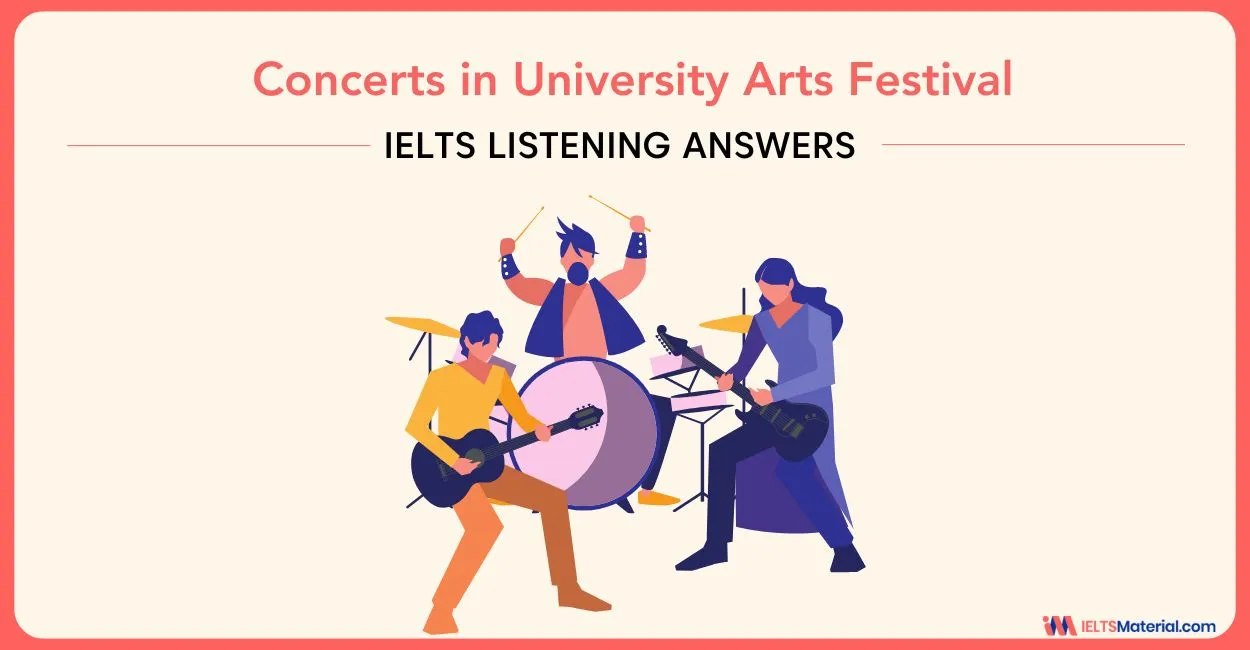
Post your Comments
Recent articles.
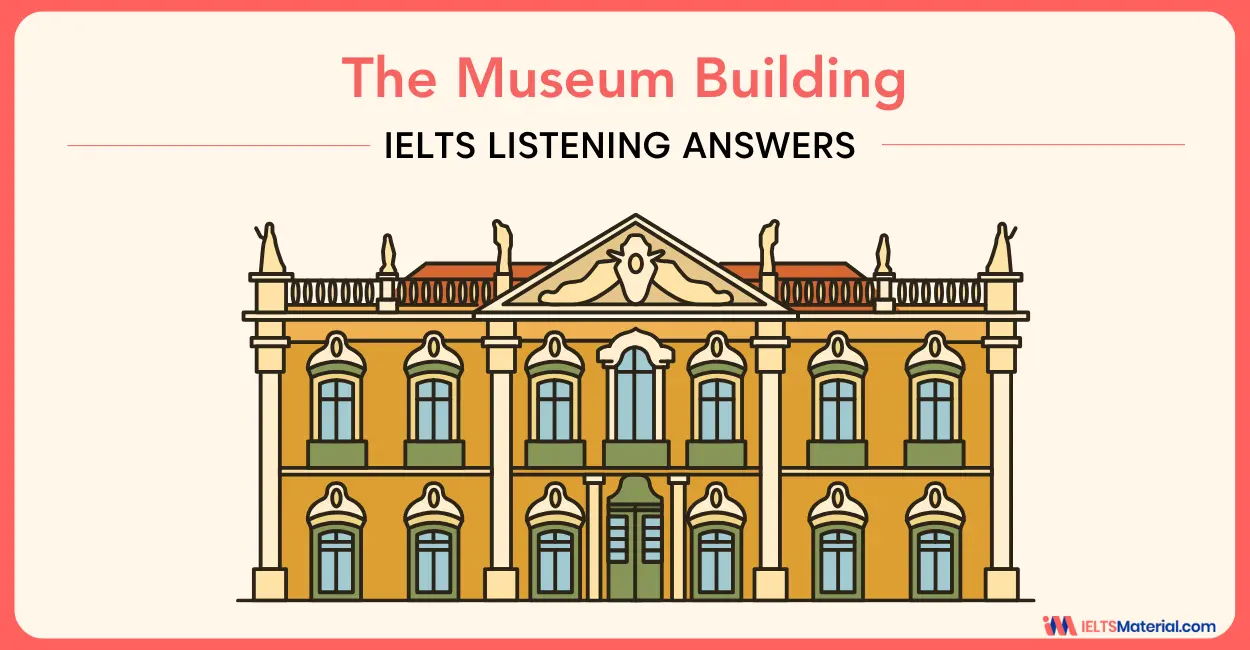
Akanksha Tripathi

Nehasri Ravishenbagam

IELTSMaterial Master Program
1:1 Live Training with Band 9 Teachers
4.9 ( 3452 Reviews )
Our Offices
Gurgaon city scape, gurgaon bptp.
Step 1 of 3
Great going .
Get a free session from trainer
Have you taken test before?
Please select any option
Email test -->
Please enter Email ID
Mobile Band 9 trainer -->
Please enter phone number
Application
Please select any one
Already Registered?
Select a date
Please select a date
Select a time (IST Time Zone)
Please select a time
Mark Your Calendar: Free Session with Expert on
Which exam are you preparing?
Great Going!
- Luyện thi IELTS
- Luyện thi TOEIC
- Luyện thi HSK
- Tiếng Anh Giao Tiếp
- Luyện đề IELTS
- Luyện đề TOEIC
- Luyện đề THPTQG
Search blog
Exploring common ielts listening question types that frequently appear.
Listening often serves as the saving grace for many candidates, substantially enhancing their Overall band score. Hence, honing your Listening skills at home can bolster your confidence in hitting the mark during the actual test. How many types of questions in IELTS Listening are there? In this article, let's delve into the intricacies of the most prevalent IELTS Listening Question Types, in collaboration with prepedu.com.
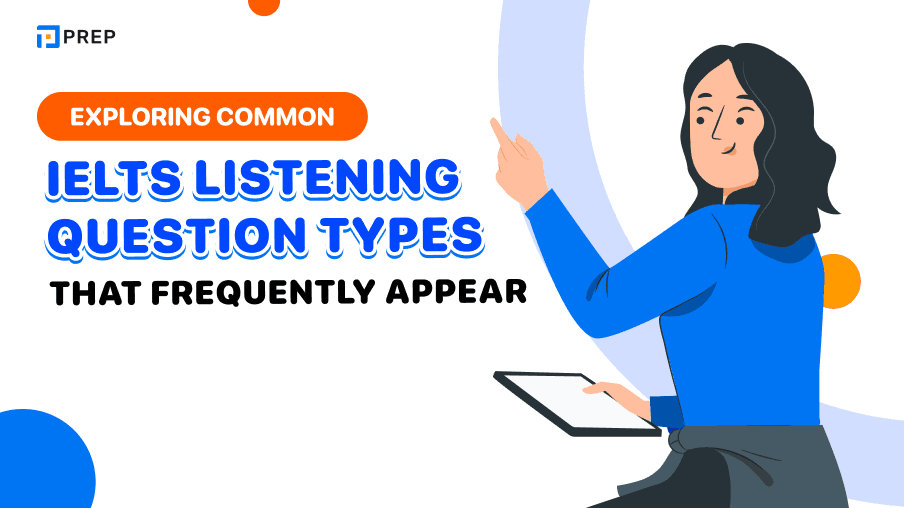
1. Type and format of Multiple Choice Questions
2. task of multiple choice questions, 1. type and format of matching questions, 2. task of matching questions, 1. type and format of plan, map, diagram labelling questions, 2. the goal of plan, map, diagram labelling questions, 1. type and format of form, note, table, flow-chart, summary completion questions, 2. the goal of form, note, table, flow-chart, summary completion questions, 1. type and format of sentence completion questions, 2. the goal of sentence completion, 1. type and format of short-answer questions, 2. the goal of short-answer questions, i. ielts listening question types: multiple choice.
Multiple Choice is one of the most common and fundamental types of IELTS Listening questions. You will encounter many questions of this type while studying English for IELTS Online. In this question type, a question will have 3 answer options, or there will be 3 ways to complete a sentence at the beginning. Test takers must choose one correct answer - A, B, or C.
Sometimes, candidates are provided with a longer list of possible answers and are required to choose more than one. In this case, read the question carefully to check how many answers are required.

Multiple Choice questions assess a range of skills of the test taker. Candidates may be asked to understand the details of the listening passage. Familiarize yourself with the following tips to do well in this question type in IELTS Listening during your self-study at home or in the actual test room:
- Multiple Choice Questions in IELTS Listening often appear in the third section of the test.
- There is no foolproof technique to choose the correct answer 100%. Therefore, listen carefully to the content in the audio to avoid traps and select the correct answer.
- Multiple Choice is considered one of the most difficult question types in IELTS Listening because it contains the most traps. Study the synonyms in the question, and answer options, and listen carefully to the audio to avoid mistakes.
Please refer to the following article:
- 5 Steps to Mastering IELTS Listening Multiple Choice and Achieving a High Score
II. IELTS Listening Question Types: Matching
Matching is a highly popular question type in IELTS Listening. Test takers have to match a list of items from the listening passage with a set of options on the test paper. The questions in the test will be numbered 1, 2, 3,... and the answers will be labeled with letters A, B, C, etc. to make the best match.
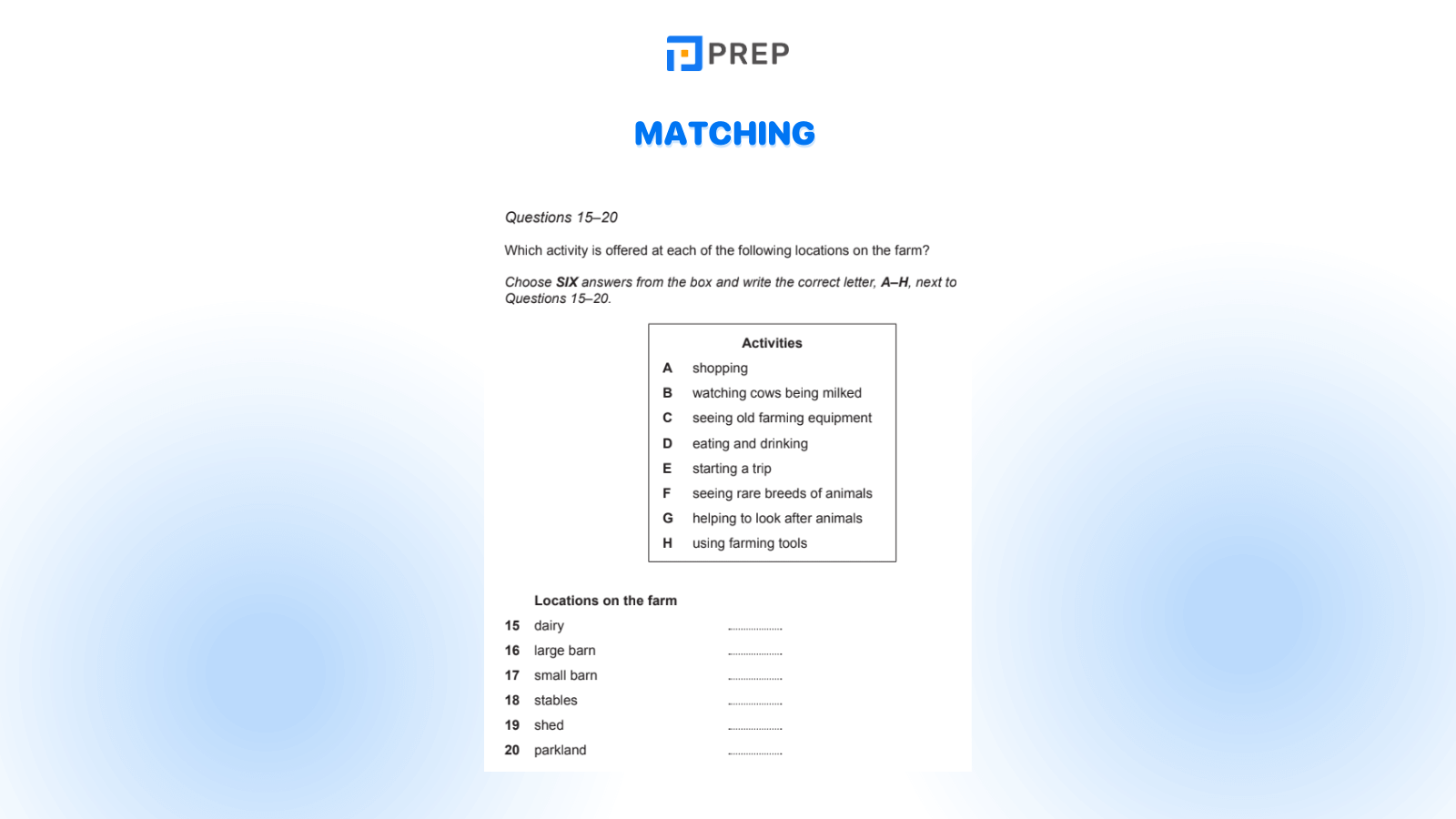
The Matching task assesses the ability to listen for details and whether the test taker can understand the information presented in a conversation about everyday topics, such as types of hotels, restaurants, etc.
This IELTS Listening task also evaluates the ability to follow a conversation between two people. The Matching task can also be used to assess the candidate's ability to recognize relationships and connections between the information in the listening passage.
Tips for doing Matching questions:
- Matching - the question type in IELTS Listening is considered a test that can make candidates lose their calm, concentration, and points because they have to listen carefully while making the correct connections.
- Therefore, to master this test, as well as achieve a high score in the real test, practice listening and making accurate connections during your self-study at home.
- How to quickly handle the IELTS Listening Matching Information
III. IELTS Listening Question Types: Plan, Map, Diagram Labelling
Plan, Map, Diagram Labelling is a highly popular question type in IELTS Listening. Test takers are required to complete blanks that need to be filled in on a plan (e.g., a building), map (e.g., a section of a town), or diagram (e.g., a piece of equipment). The answers are usually selected from a list on the question paper.
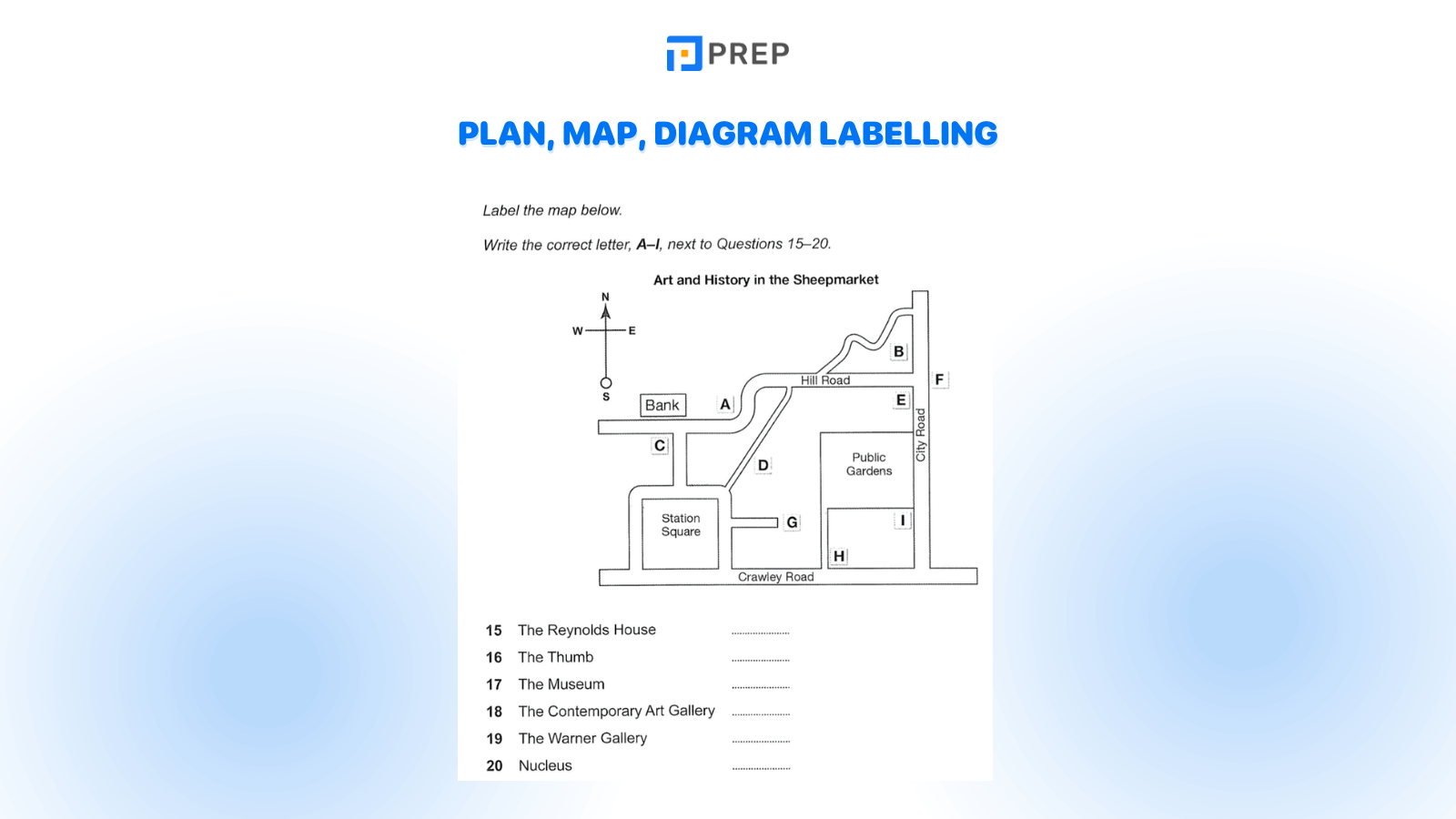
The Plan, Map, Diagram Labelling task assesses the test taker's understanding ability. For example, describing a location and relating it to a representative image. This may involve being able to follow language that expresses relationships and spatial directions (e.g., straight ahead, through the far door).
Tips for doing the task:
- 4 steps to conquer the Plan/Map Labelling task in IELTS Listening
- Effectively Tackling Diagram Labelling in IELTS Listening with 4 Steps
IV. IELTS Listening Question Types: Form, Note, Table, Flow-chart, Summary Completion
Test takers will be asked to fill in the blanks in a form after listening to a recorded audio as follows:
- Form: recording factual details such as names of individuals or organizations;
- Note: summarizing any information in a given layout, highlighting related categories;
- Table: summarizing information related to categories in the form. For example: location, time, prices, etc.;
- Flowchart: summarizing a process with clear stages. The direction of the process in the form is indicated by arrows.
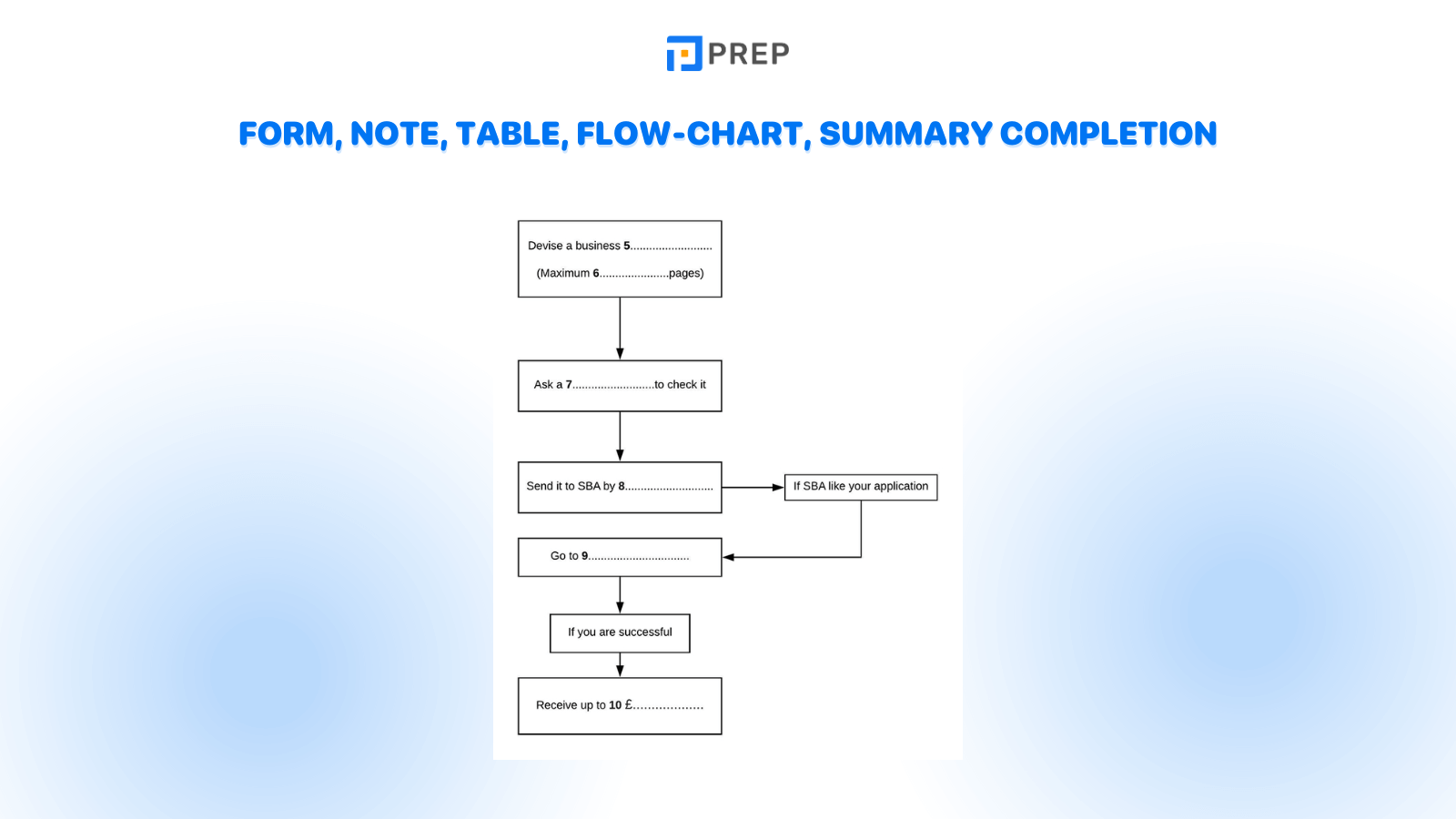
Test takers should carefully read the instructions as the number of words or numbers they should use to fill in the blanks will vary. A word limit is provided, for example: NO MORE THAN TWO WORDS AND/OR A NUMBER. Test takers will be penalized for writing more words than specified, and they should check this word limit for each task. Hyphenated words are counted as one word.
- 6 steps to effectively tackle the Note Completion in IELTS Listening
- How to do Summary Completion & Table Completion in IELTS Listening
This is a highly popular question type in IELTS Listening. The Form, Note, Table, Flowchart, and Summary Completion questions focus on the main points that the listener will naturally record in this type of situation.
- Form, Note, Table, Flowchart, and Summary Completion questions often appear in IELTS Listening Part 1.
- In the audio, the speakers often change their intentions (location/date/time/prices, etc.). Therefore, it is important to listen carefully to avoid traps and provide the most accurate answers.
- Typically, the answers you need to fill in are either a number or a word (number/letter).
V. IELTS Listening Question Types: Sentence Completion
Test takers are required to read a set of sentences summarizing key information from all the listening passages or a part of it. They then fill in the blanks in each sentence using information from the listening. A word limit is provided, for example: "NO MORE THAN ONE WORD AND/OR A NUMBER."
Test takers lose marks if they write more words than specified. (Test takers should carefully check this word limit for each task: the limit is ONE, TWO, or THREE words). Hyphenated words are counted as one word.
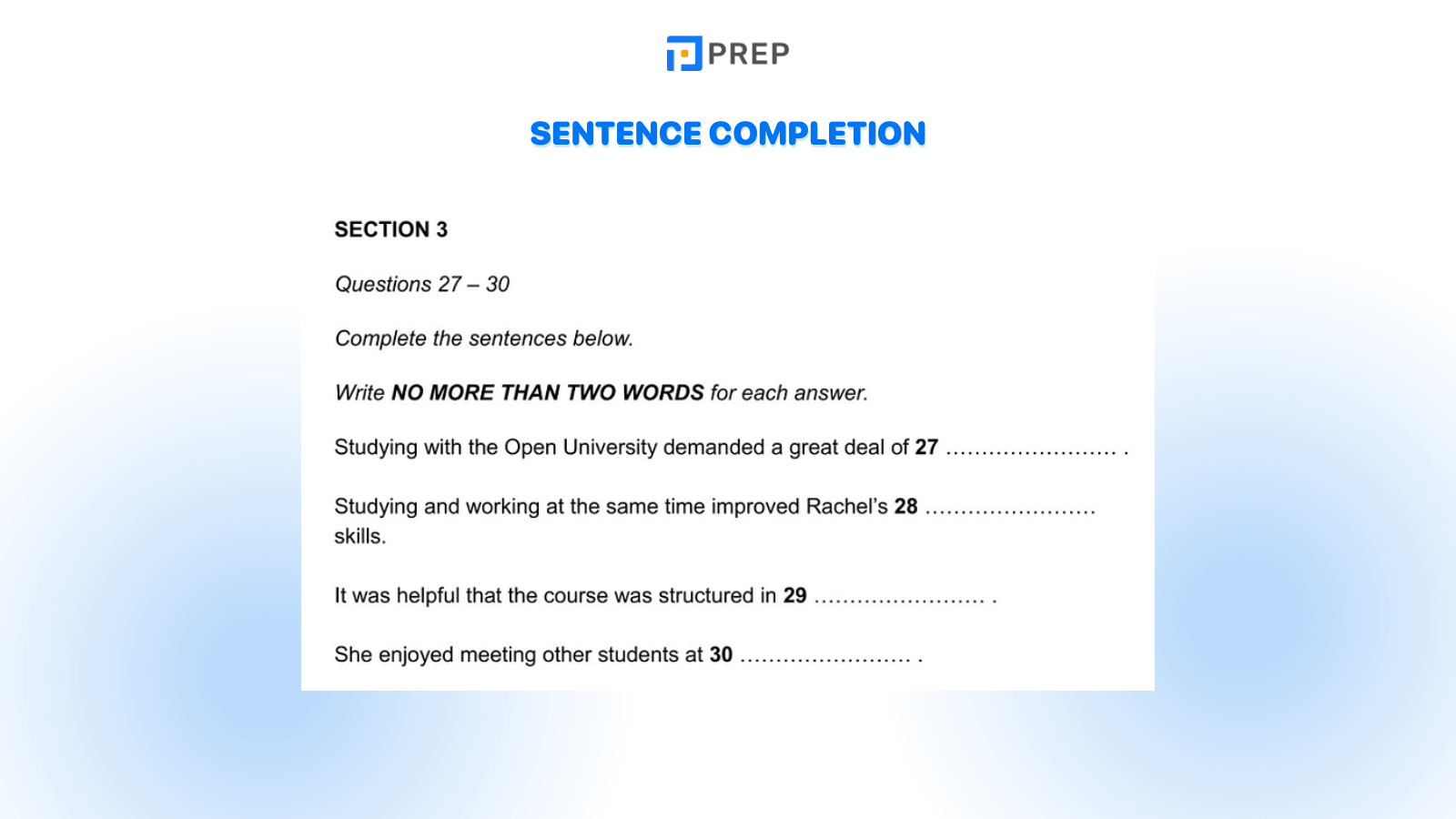
The Sentence Completion question type assesses the test taker's ability to identify key information in a listening passage. Test takers must understand functional relationships such as cause and effect.
Tips for doing the task:
- Read the instructions carefully and fill in the correct number of words specified. If you provide more words than the given word limit, you will not receive points for that question. If the requirement is "ONLY ONE WORD," you can only write one word. If the requirement is "NO MORE THAN TWO WORDS," you can write up to two words.
- Identify the content of this question type in IELTS Listening to accurately understand the sentences and parts of the task.
VI. IELTS Listening Question Types: Short-answer Questions
Test takers are required to read a question and then write a short answer using information from the listening. A word limit is provided, for example: "NO MORE THAN THREE WORDS AND/OR A NUMBER." Test takers lose marks if they write more words than specified. Hyphenated words are counted as one word.
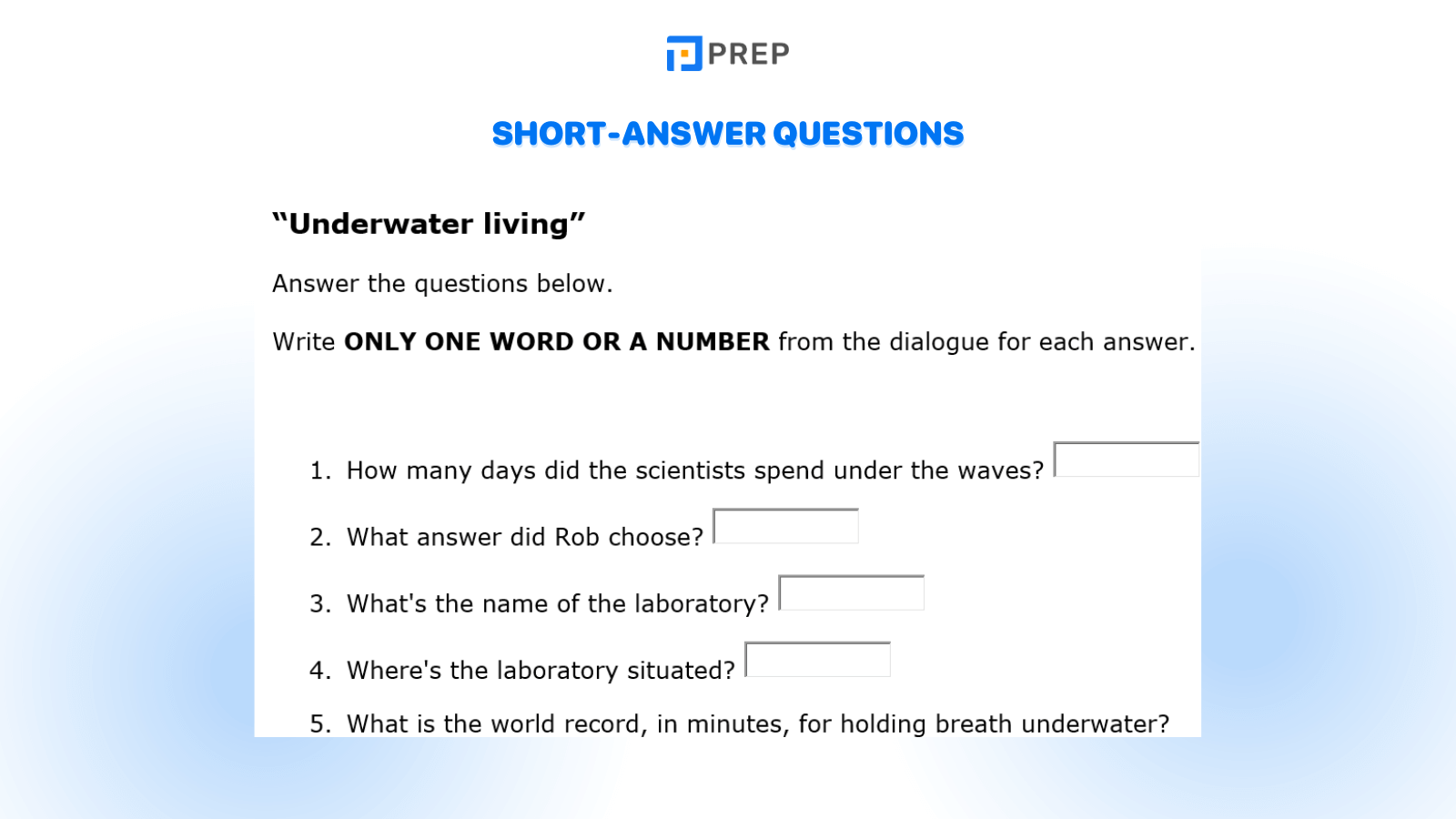
The Short-answer Questions type assesses the test taker's ability to listen for specific details, such as locations, prices, or times, in the listening passage.
- Read the instructions carefully and provide the correct number of words specified. If you provide more words than the given word limit, you will not receive points for that question. If the requirement is "ONLY ONE WORD," you can only write one word. If the requirement is "NO MORE THAN TWO WORDS," you can write up to two words.
- This question type does not provide any hints, so you need to listen carefully to the audio to provide accurate answers.
This article has provided some important and very useful information about the 6 most common IELTS Listening Question Types. Hopefully, the above knowledge will help you prepare well and achieve high scores in the upcoming Listening test.
You will master all 6 question types in IELTS Listening in the courses at Prep. Register for a suitable IELTS preparation course that aligns with your goals at Prep.

Đăng ký tư vấn lộ trình học
Bạn hãy để lại thông tin, Prep sẽ liên hệ tư vấn cho mình ngay nha!

How to Prepare for a Presentation: Reading Answers
IELTS General Test – Passage 08: How to Prepare for a Presentation reading with answers explanation, location and pdf summary. This reading paragraph has been taken from our huge collection of Academic & General Training (GT) Reading practice test PDF’s.

How to Prepare for a Presentation
The first time your boss suggests that you formally present something to your department or a client, your reaction may be to panic. But remember that being asked to present is a compliment. Someone believes that you have valuable information to share with the group, and wants to listen to your ideas. You need to decide exactly what you will say during the allotted time. Condense your topic into one sentence. What do you want your audience to remember or learn from your talk? This is your ‘big idea’. Remember that you are dealing with the short attention spans of individuals who tend to have many things on their minds. Think of three main points you want to make to support your overall topic. Develop a story to demonstrate each of those concepts. This could be something that happened to you or someone you know, or something you read in a newspaper or magazine. We have all heard the saying A picture is worth a thousand words . Think about how your presentation can be more interesting to watch. Props are a wonderful way to make your talk come alive. You could do something as simple as holding up a toy phone receiver when talking about customer service or putting on a hat to signal a different part of your talk. Think of a dynamic and unusual way to start your presentation. This might involve telling anecdotes that relate to your topic. Never begin with, Thank you for inviting me here to talk with you today! You will put your audience to sleep right away. Start off enthusiastically so they will listen with curiosity and interest. After your energetic introduction, identify yourself briefly and thank the audience for taking the time to listen to you. Plan your ending, and finish in a memorable way. Your listeners remember best what they hear at the beginning and end of a speech, so conclude with a game in which they can participate, or tell a humorous story and your audience will leave laughing. Don’t try to memorise your talk or read it word-for-word. It will sound stilted and boring, instead, practise your dynamic introduction and conclusion until you can deliver them effortlessly. If you do this you’ll feel a burst of confidence that will help you sail through the whole of the speech.
Questions 21-27
Complete the sentences below. Choose ONE WORD ONLY from the text for each answer. Write your answers in boxes 21-27 on your answer sheet.
• You should regard an invitation to speak as a 21 ……………………….. . • Express your main idea in a 22 ……………………….. . • Try using a 23 ……………………….. to support the major points you are making. • Add visual excitement to your talk by using 24 ……………………….. . • Express appreciation to your listeners for their 25 ……………………….. . • A 26 ……………………….. will get the audience to interact. • It is important to prepare well as this will increase your 27 ……………………….. .
________________
1) IELTS 9 READING PASSAGE – JLP RETAIL: STAFF BENEFITS ↗
2) IELTS 9 READING PASSAGE – THE YOUNG PERSON’S RAILCARD ↗
3) IELTS 9 READING PASSAGE – OUT OF THE ASHES ↗
Check out How to Prepare for a Presentation reading answers below with explanations and locations given in the text.
21. compliment 22. sentence 23. story 24. props 25. time 26. game 27. confidence
If you want the pdf summary of X reading passage and answers, please write your email in the comment section below. We’ll send it across at the speed of light.

ALL THE BEST !
2 thoughts on “How to Prepare for a Presentation: Reading Answers”
As a teacher I find this passage is very useful for my students and i am going to use it during my class. Thank you for uploading.
So glad to hear that. Feel free to put these IELTS Reading practice tests into use!
Leave a Comment Cancel reply
Save my name, email, and website in this browser for the next time I comment.
IELTS TEST TYPES
✓ IELTS Academic
✓ IELTS General Training
USEFUL LINKS
✓ IELTS Full Form
✓ IELTS Band Score
✓ IELTS Vocabulary
✓ IELTS Grammar
CONNECT WITH US
Pinterest ↗
IELTS® is a registered trademark of The British Council, IDP- IELTS Australia and the University of Cambridge ESOL Examinations (Cambridge ESOL). This site and its owners are not affiliated, approved or endorsed by the University of Cambridge ESOL, the British Council, IELTS Progress Check, and IDP Education Australia. "IELTS Progress Check" is the name of the official IELTS online practice test and is in no way affiliated with this website. To find out more about the official IELTS online practice test please visit https://www.ieltsprogresscheck.com/.
ABOUT US | PRIVACY POLICY | DISCLAIMER | TERMS | CONTACT US
© 2023 IELTSPROGRESS.COM | All Rights Reserved

IELTS Listening Practice Test
Preparing And Giving A Presentation
Question 1 - 10
Complete each sentences with correct ending
ĐÁP ÁN & GIẢI THÍCH CÂU 1

- Nội dung giải thích được viết bởi DOL IELTS Đình Lực - Học Viện Tiếng Anh Tư Duy đầu tiên tại Việt Nam
- Đề được viết bởi nhà xuất bản lớn gồm Cambridge và Oxford

TUTOR: Ah … come in, Russ.
RUSS: Thank you.
TUTOR: Now you wanted to consult me about your class presentation on nanotechnology – you’re due to give it in next week, aren’t you?
RUSS: That’s right. And I’m really struggling. I chose the topic because I didn’t know much about it and wanted to learn more, but now I’ve read so much about it, in a way there’s too much to say – I could talk for much longer than the twenty minutes I’ve been allocated. Should I assume the other students don’t know much, and give them a kind of general introduction, or should I try and make them share my fascination with a particular aspect?
TUTOR: You could do either, but you’ll need to have it clear in your own mind.
RUSS: Then I think I’ll give an overview.
TUTOR: OK. Now, one way of approaching this is to work through developments in chronological order.
RUSS: Uh-huh.
TUTOR: On the other hand, you could talk about the numerous ways that nanotechnology is being applied.
RUSS: You mean things like thin films on camera displays to make them water-repellent, and additives to make motorcycle helmets stronger and lighter.
TUTOR: Exactly. Or another way would be to focus on its impact in one particular area, say medicine, or space exploration.
RUSS: That would make it easier to focus. Perhaps I should do that.
TUTOR: I think that would be a good idea.
RUSS: Right. How important is it to include slides in the presentation?
TUTOR: They aren’t essential, by any means. And there’s a danger of tailoring what you say to fit whatever slides you can find. While it can be good to includes slides, you could end up spending too long looking for suitable ones. You might find it better to leave them out.
RUSS: I see. Another thing I was wondering about was how to start. I know presentations often begin with ‘First I’m going to talk about this, and then I’ll talk about that’, but I thought about asking the audience what they know about nanotechnology.
TUTOR: That would be fine if you had an hour or two for the presentation, but you might find that you can’t do anything with the answers you get, and it simply eats into the short time that’s available.
RUSS: So, maybe I should mention a particular way that nanotechnology is used, to focus people’s attention.
TUTOR: That sounds sensible.
RUSS: What do you think I should do next? I really have to plan the presentation today and tomorrow.
TUTOR: Well, initially I think you should ignore all the notes you’ve made, take a small piece of paper, and write a single short sentence that ties together the whole presentation: it can be something as simple as ‘Nanotechnology is already improving our lives’. Then start planning the content around that. You can always modify that sentence later, if you need to.
Questions 1-5
Choose the correct letter, A , B or C .
Planning a presentation on nanotechnology
Cambridge ielts 13 academic listening test 2 (questions 21-25).
Skyrocket your IELTS band score by 1-2 points in under a month with our premium plan! Check it out
Leave a Reply Cancel reply
Your email address will not be published. Required fields are marked *
Save my name, email, and website in this browser for the next time I comment.
| # | Your Answer | Correct Answer |
|---|
| # | Your Answer |
|---|---|
| 1 | |
| 2 | |
| 3 | |
| 4 | |
| 5 |
Plans & Pricing
OG剑桥雅思官方指南Test2 Section4听力原文与答案 Preparing and giving a presentation
剑桥雅思官方指南听力第二套题目第四部分的主题为准备演讲的步骤。具体内容包括一开始的想法,演讲的结构,演讲时的注意事项,以及遇到提问和打断应该怎么做。下面是其对应的录音原文与答案。
OG Test2 Section4听力原文
Hello everyone. You’ve all been given an assignment for your Sociology course which will involve giving a presentation to the rest of the group. And so, today, I’m going to be giving you a few tips on how to prepare your presentations. This should help you with your current assignment – but a lot of the principles I’ll be putting across will be general principles which will, of course, help you with all your future presentations.
So first of all, the most important thing to consider is your audience and in this instance, your audience are the other students in your group. There are three points to bear in mind. Firstly, you need to ask yourself what they need to know; secondly, it’s useful to consider whether they’ll be supportive (Q31) or not; and thirdly – will it be a small group, say three or four, a moderate gathering 0f twenty or so people (as for your current assignment) or will there be hundreds of people? Having said all that, what I’m about to tell you will apply equally to any audience.
So – how do you structure your presentation? Right at the beginning, you should tell them something that forces them to pay attention (Q32) . This could be something surprising or even shocking but it needs to be relevant! After that. you need a list of items or topics showing them what you’ll be covering rather like an agenda – and then the main part of the presentation will follow. This main part will be the detailed information you’ll be presenting and could include facts, statistics, personal experiences, etc. After this, you should summarise what you’ve presented and close with what I call ‘next steps’ (Q33) . For this assignment, you could simply point the group to other Sociology reference material. In other cases, you may want to suggest some actions that people can take.
Now – what about the design of the slides for your laptop? Well the important thing here is to be consistent (Q34) . You need to have the same type of font and use the same colour and size for the same elements. For example, all headers need to look the same, all bullet points need to be presented in the same way. And don’t just stick to words. Bring the presentation to life by adding graphics (Q35) . These could be in several forms such as pictures, flow-charts, diagrams, histograms and so on.
And so – let’s move on now to presenting. You have your presentation prepared and you’re ready to start. Well – it’s important to give a good impression from the start. So take three deep breaths, look at the audience, no matter how frightening they may be, and be enthusiastic and energetic. As you go through the presentation remember to provide some variety in the way you speak. So, for example, you can talk fairly rapidly Ior information that may be familiar, but then slow down for more unfamiliar sections. And change your tone (Q36) as you speak – don’t keep it at the same level all the way through. As I mentioned, look at your audience. Er, a good tip is to pick people out and look at them for around five seconds. Not looking at the audience gives the impression that you’re either not interested in them or terrified of them. Looking too long at one particular person may make them feel rather uncomfortable. There may be points in your presentation that you want your audience to really absorb and in order to make important points stand out you may consider adding silence (Q37) right after these. It will give people time to reflect on what you’ve just said. Also – you may be presenting complicated ideas or technical details but try to keep everything as simple as possible. Use simple words and as few as possible, And be clear. If you say something like ‘this appears to be’, it implies uncertainty. So using weak verbs (Q38) such as ‘appears, ‘seems’, ‘could be’, etc. needs to be avoided.
I’ll just finish off with a few thoughts on questions and interruptions from the audience. You may choose to invite questions from the audience as you go or ask them to wait until the end. Either way, questions should be encouraged as it provides you with some feedback on how interested the audience is and how well they’re understanding you. When a question is asked you need to provide an answer that is as accurate as possible. So initially, my tip is to repeat it (Q39) . This will ensure you have heard it correctly and will give you a few seconds to gather your thoughts.
Interruptions, on the other hand, can be unwelcome and you may get them for a variety of reasons, It’s likely, however, that there’s something in your presentation that’s unclear or confusing. So my advice is to reduce problems by reading through your presentation beforehand and predicting (Q40) potential points which could cause interruptions. You may then want to change that part of your presentation or, at least, you will be prepared if someone does interrupt you. Now, do you have any questions …
OG Test2 Section4听力答案
31. supportive
32. pay attention
33. next steps
34. consistent
35. graphics
37. silence/silences
38. weak verbs
39. repeat it
40. predicting
OG剑桥雅思官方指南Test2 Section1听力原文与答案 Short story competition
OG剑桥雅思官方指南Test2 Section2听力原文与答案 Sea Life Centre – information
OG剑桥雅思官方指南Test2 Section3听力原文与答案 Experience of University
雅思口语跟阅读听力同天考吗?
雅思机考听力会发纸吗?.
Tags: OG剑桥雅思官方指南听力原文与答案
剑桥雅思18Test4Part4听力原文与答案 Victor Hugo
剑桥雅思18test4part3听力原文与答案 origami, 剑桥雅思18test4part2听力原文与答案 museum of farming life, 剑桥雅思18test4part1听力原文与答案 job details from employment agency, leave a reply cancel reply.
Save my name, email, and website in this browser for the next time I comment.
- India Today
- Business Today
- Harper's Bazaar
- Brides Today
- Cosmopolitan
- India Today Hindi
- Reader’s Digest
- Aaj Tak Campus
10 easy tips to ace your IELTS listening test
Scoring well in the ielts listening section is crucial for those planning to study or migrate to english-speaking countries. with the right preparation and strategies, you can achieve a high score and move closer to your goals. here are some tips to help you excel in this section of the test..
Listen to Story

It is important to score well in the English Language test if one plans to study or migrate to an English-speaking country. IELTS, the most popular English Language Test worldwide, was trusted by more than 40 lakh candidates last year and is recognised by more than 12000 organisations across 140+ countries. It is a simple test that assesses listening, reading, writing, and speaking skills. It is 2 hours and 45 minutes, and one can take the IELTS on a computer or paper, depending on their convenience.
UNDERSTANDING THE IELTS LISTENING FORMAT
The IELTS Listening test remains the same for the IELTS Academic and General Training. There is no difference in format, content, difficulty level and scoring. The test duration is 30 minutes. Depending on the format, you will be given extra time to transfer the answers to the final answer sheet.

IELTS Speaking Practice Questions
Using the most popular IELTS speaking topics and answers, you’ll practice with a free IELTS speaking test in this guide. With the help of our thoroughly tested speaking templates, you will discover how to respond to IELTS Speaking Parts 1, 2, and 3.
After finishing an IELTS speaking practice exam, receive free IELTS speaking sample answers.
IELTS Speaking Part 1
Hometown & weather, question 1: what is your country famous for.
Answer: My country is famous for its rich cultural heritage and beautiful landscapes. We have stunning historical monuments, delicious cuisine, and vibrant festivals that attract tourists from all over the world.
Question 2: Where do you live in your country?
Answer: I live in the capital city, which is a bustling metropolis with a mix of modern and traditional architecture. It’s a lively place with lots of opportunities and amenities.
Question 3: Is it an interesting place to live?
Answer: Yes, it is a very interesting place to live. There are always events and activities happening, from cultural festivals to sports events. Plus, there are many parks and recreational areas where people can relax and enjoy nature.
Question 4: Are you planning to live there in the future?
Answer: I’m not entirely sure if I’ll live here forever. While I love my city, I’m also open to exploring opportunities in other places, possibly abroad, for a different experience and career growth.
Question 5: How is the weather today?
Answer: Today, the weather is quite pleasant. It’s sunny with a gentle breeze, making it a perfect day to be outdoors.
Volunteer Work
Question 1: Have you ever worked before? Answer: Yes, I have worked before. I had a part-time job at a local café during my college years.
Question 2: What was your first day at work like? Answer: My first day at work was exciting but nerve-wracking. I had to learn a lot of new things quickly, but my colleagues were very supportive and helped me adjust.
Question 3: What responsibilities did you have at work? Answer: My responsibilities included taking orders, serving customers, handling payments, and ensuring the café was clean and welcoming.
Question 4: What was your typical day like at work? Answer: A typical day at work involved opening the café, serving customers during the busy morning rush, restocking supplies, and closing up at the end of the day.
Question 5: Have you taken any volunteer works? Answer: Yes, I have participated in several volunteer works. I volunteered at a local animal shelter and helped with organizing community events.
Books and TV
Question 1: Do you like watching TV?
Answer : Yes, I enjoy watching TV, especially in the evenings after a long day. It helps me relax and unwind.
Question 2: How often do you watch TV?
Answer : I watch TV almost every day, usually for about an hour or two. On weekends, I might watch a bit more if there’s something interesting on.
Question 3: What kind of TV programmes do you like to watch?
Answer : I like watching a variety of programmes, but my favorites are documentaries and crime dramas. I also enjoy comedy shows for a good laugh.
Question 4: What are the most popular TV shows in your country?
Answer : In my country, reality TV shows and soap operas are very popular. Shows like “The Voice” and “Big Brother” have a huge following, as well as local dramas.
Question 5: Has the internet affected your viewing habits?
Answer : Yes, definitely. With streaming services like Netflix and YouTube, I now watch more content online than on traditional TV. I can watch shows whenever I want, without having to follow a TV schedule.
IELTS Speaking Part 2
Question: Talk about a sculpture you would like to have in your home. You should say:
- How you know about it
- How much it would cost you
- And explain why you want to have it in your home.
One sculpture I would love to have in my home is “The Thinker” by Auguste Rodin. This iconic piece depicts a man deep in thought, with his chin resting on his hand. I first learned about “The Thinker” during an art history class in high school, and I was immediately captivated by its powerful expression of contemplation and introspection. The cost of owning an original “The Thinker” would be astronomical, likely millions of dollars, as it is one of Rodin’s most famous works. However, even a high-quality replica would be a significant investment, probably costing several thousand dollars. I want to have “The Thinker” in my home because it symbolizes deep thought and intellectual pursuit, values that are very important to me. Having this sculpture in my living space would serve as a constant reminder to always think critically and reflect on the world around me. Additionally, its artistic beauty would enhance the aesthetic appeal of my home, making it a more inspiring and cultured environment.
Talk about a book you are reading now or have read recently. You should say:
- How and why you got it
- How long it took you to read it or how long you have been reading it
- What kind of book it is
- And say if you would like to read something else similar or not, and why
One book I read recently is “The Alchemist” by Paulo Coelho. I got this book as a gift from a friend who highly recommended it to me, knowing that I enjoy inspirational and philosophical stories. It took me about two weeks to read it, as I like to take my time absorbing the deeper meanings and reflecting on the lessons presented in the story. “The Alchemist” is a novel that falls under the category of adventure and self-help, telling the tale of a young shepherd named Santiago who embarks on a journey to find a hidden treasure, only to discover profound truths about life and his own destiny. I would definitely like to read more books similar to “The Alchemist” because I find them very enriching and thought-provoking. These types of books offer more than just entertainment; they provide insights and perspectives that can be applied to real life, encouraging personal growth and self-discovery.
Topic 1: Describe a successful small business you know.
You should say:
- what the business is
- how you know about it
- what products or services it offers
- and explain why you think it is successful.
One successful small business I know is a local bakery called “Sweet Delights.” I first heard about this bakery through a friend who recommended their delicious pastries. Sweet Delights offers a variety of baked goods, including cakes, cookies, and artisan bread. They are particularly famous for their custom-made celebration cakes. The bakery’s success can be attributed to the high quality of their products, the creativity in their designs, and their excellent customer service. Additionally, they have a strong presence on social media, which has helped them attract a loyal customer base. The combination of quality, innovation, and effective marketing has made Sweet Delights a thriving business in our community.
Speaking Part 3 (Follow-Up Questions)
Part 3 of the IELTS speaking exam will consist of 4–8 additional questions related to the themes covered in Part 2 of the test. The entire part three will be a two-way conversation with the examiner, lasting four to five minutes. The examiner will also ask you a few questions depending on your responses. Based on the aforementioned IELTS speaking part 2 themes, the examiner may ask you the following general speaking questions:
Question 1: Do you think art is important in our daily lives? Why or why not?
Answer: Yes, art is important because it adds beauty, expresses emotions, and can inspire creativity and thought.
Question 2: How has modern technology changed the way we experience art?
Answer: Modern technology has made art more accessible through online galleries and virtual reality, allowing people to experience and create art in new ways.
Question 3: Should governments support art and artists? Why or why not?
Answer: Yes, governments should support art and artists to preserve cultural heritage, promote creativity, and enhance public spaces.
Topic: Books
Question 1: Do you think reading books is more beneficial than watching TV? Why or why not?
Answer: Yes, reading books is often more beneficial because it improves concentration, enhances imagination, and develops language skills.
Question 2: How do you think digital books compare to physical books?
Answer: Digital books are convenient and portable, but physical books provide a tactile experience and can be easier on the eyes.
Question 3: What kind of books are popular in your country?
Answer: In my country, genres like fiction, self-help, and educational books are very popular.
Topic: Business
Question 1: What are the advantages and disadvantages of running a small business?
Answer: Advantages include independence and potential financial rewards. Disadvantages are the risk of failure and the demands on time and resources.
Question 2: Do you think it’s better to start a business alone or with partners? Why?
Answer: It depends. Starting alone offers full control, while partners can provide complementary skills and share the workload and risk.
Question 3: How important is it for a small business to have an online presence?
Answer: It is very important because an online presence increases visibility, reaches a broader audience, and can boost sales through e-commerce.
IELTS Listening Practice Questions
The listening portion of the IELTS Academic and General Training tests is identical. You will be required to respond to four recordings with 40 questions.
Four recordings totaling a combination of monologues and conversations from various native speakers will be played for you; each recording will only be heard once. Every section of the Listening test consists of ten questions.
Topic: University Course Selection
Instructions : What does the student say about each of the following course options? Write the correct letter, A, B, or C next to each course. You may choose any letter more than once.
A. He’ll definitely do it. B. He may or may not do it. C. He won’t do it.
Questions 1-5:
- Environmental Science
- World History
- Creative Writing
- Computer Programming
Transcript:
Advisor : Come in. Hello, Jamie. Have a seat. You mentioned wanting to discuss your course options for next semester? Jamie : Yes, that’s right. We need to finalize our choices by the end of the month. I’m torn between several interesting courses. Advisor : I see. You’re majoring in English Literature, correct? Jamie : Yes, that’s correct. Advisor : Let’s go through your options then. First, there’s the Modern Art course. It’s an overview of art movements from the 19th century to present day. Jamie : Modern Art sounds intriguing, but I think I’d prefer something more directly related to my major. So, I’ll pass on that. Advisor : Got it. What about Environmental Science? It’s a great course if you’re interested in current environmental issues and sustainability practices. Jamie : That’s definitely interesting. I’m not entirely sure yet, but I’m leaning towards it. Advisor : Okay. How about World History? This course covers significant historical events and their global impacts. Jamie : I’ve always been fascinated by history, so I’m definitely interested. I’ll sign up for this one. Advisor : Great. Next, there’s Creative Writing, which focuses on developing your writing skills and exploring various literary genres. Jamie : That sounds perfect for me. I’ve been wanting to improve my writing skills, so I’m definitely going to take this one. Advisor : Excellent choice. Lastly, we have Computer Programming. It’s an introductory course that covers the basics of coding and software development. Jamie : I’m not really into programming. I’ll skip that one.
Questions :
- (Answer: C. He won’t do it)
- (Answer: B. He may or may not do it)
- (Answer: A. He’ll definitely do it)
Plan Labelling
University Campus Tour
Instructions : Label the plan below. Choose FIVE answers from the box and write the correct letters A-I next to questions 1-5.

Options: A. Cafeteria B. Computer Lab C. Gymnasium D. Lecture Hall E. Library F. Main Office G. Parking Lot H. Science Building I. Student Union
Transcript: Tour Guide : Welcome, everyone, to our university campus tour. My name is Sarah, and I’ll be showing you around today. Let’s start here at the main entrance. To your right, you’ll find the Main Office (F), where you can handle administrative matters like registration and student services. Just opposite the main office is our Library (E), which houses a vast collection of books and study resources. If you continue down the main hallway, you’ll see the Computer Lab (B) on your left, equipped with the latest technology for all your computing needs. Next to the computer lab is the Science Building (H), where you’ll find all the science classrooms and laboratories. As we move forward, on your right, you’ll notice the Lecture Hall (D), which hosts large classes and guest lectures. Across from the lecture hall, you’ll see the Cafeteria (A), a great place to grab a meal or snack between classes. Towards the back of the campus, you’ll find the Gymnasium (C), equipped with various fitness facilities. Nearby is the Student Union (I), a hub for student activities and events. Finally, outside the main building, there is the Parking Lot (G) for students and faculty. I hope this tour gives you a good sense of our campus layout. Now, let’s proceed to our first stop, the library.
- (Answer: F)
- (Answer: E)
- (Answer: B)
Multiple Choice
Listen to the conversation and choose the correct letter, A, B, or C.
- B. Standard
Agent : OK right. Now, obviously, insurance is an important thing to consider, and our companies are able to offer very good rates in a number of different all-inclusive packages. Customer : Sorry, could you explain a bit more? Agent : Yes, sorry. There are really three rates according to the quality of insurance cover. There’s the highest comprehensive cover, which is Premium rate, then there’s Standard rate, and then there’s Economy rate. That one will only cover the cost of the contents second hand. Customer : Oh, I’ve been stung before with economy insurance, so I’ll go for the highest. Agent : Mh’hm. And can I just check, would you want home delivery or to a local depot, or would you want to pick it up at the nearest port? Customer : The port’d be fine – I’ve got transport that end. Agent : Fine. And will you be paying by credit card? Customer : Can I pay by cheque?
Also Read: Latest IELTS Writing Task 1 Topics 2024- (Graphs, Charts, Maps, Processes) Common IELTS Writing Task 2 Topics 2024 Boost Your Reading Speed and Accuracy for IELTS Reading Test IELTS Common Speaking Topics With Answers Part 1, Part 2 & Part 3
Please Login to comment...
Similar reads.
- Study Abroad
- IELTS Practice Paper
Improve your Coding Skills with Practice
What kind of Experience do you want to share?

IMAGES
VIDEO
COMMENTS
Giving a Presentation - Section 4
Choose the correct letter, A, B or C. 1 Before giving her presentation, Kate was worried about. A being asked difficult questions. B using the projection equipment. C explaining statistical results. 2 During many presentations by students, Martin feels that. A the discussion of research methods is not detailed enough.
Finally, Martin confirms his agreement ('Well, OK.'), and you can now safely choose option C as the correct answer. Step 3 - Listen and do the task. Giving the presentation listening practice test has 10 questions belongs to the Step-by-step Guide subject. In total 10 questions, 5 questions are Multiple Choice form, 5 questions are Matching form.
[0:00] 01 Unit 2 - Example Activity [0:32] 02 Unit 2 - Practice Listening Activity 1 [4:01] 03 Unit 2 - Practice Listening Activity 2 [6:12] 04 Unit 3 - Prac...
Prepare for your IELTS Listening test with part 4 of this free Listening practice test. Listen to the audio and answer questions 31 - 40. ... IELTS practice Listening test audio: part 4. First, listen to the audio. Left click on the link to listen now (the audio player will open in a new tab) or right click and select 'Save Link As' to download ...
Well, it's important to give a good impression from the start, so take three deep breaths. Look at the audience, no matter how frightening they may be, and be enthusiastic and energetic. As you go through the presentation. Remember to provide some variety in the way you speak.
IELTS Listening Test Info. The IELTS Listening Test is divided into 4 sections. In each section, you will listen to one or more native English speakers then answer around 10 questions related to what you just heard. The entire IELTS listening section contains 40 questions in total.In general, the listening recordings start off easier and get harder as you progress through the exam.
Prepare for your IELTS Listening test with part 2 of this free Listening practice test. Listen to the audio and answer questions 11 - 20. ... IELTS practice Listening test audio: part 2. First, listen to the audio. Left click on the link to listen now (the audio player will open in a new tab) or right click and select 'Save Link As' to download ...
GIVING A SPEECH. Reasons for nervousness. Lecturers often feel more nervous if a speech is 31.. Many think that the ability to make a good public speaking is 32., while in fact it is a skill that can be learned by anyone. How to prepare a quality speech. The audience will only remember the 33. sentence of speech. Ensure that your speech is 34..
Free IELTS Listening Practice Test. We have prepared a full IELTS Listening practice test (same as the real exam) with an audio player, answers and audio transcript that you can take for free to test your listening skills. Use the following steps to complete your IELTS Listening test: Grab a pencil and paper. Start the audio player (tracks play ...
Luyện tập đề IELTS Listening Practice với Preparing And Giving A Presentation được lấy từ cuốn sách IELTS Official Cambridge Guide to IELTS - Test 2 - Section 4 kèm Answer key, list từ vựng IELTS cần học trong bài đọc và Free PDF & Audio Transcript Download với trải nghiệm thi IELTS trên máy và giải thích đáp án chi tiết bằng Linearthinking
Also, practice listening to English audio recordings. This will help you get used to the sound of English and the accent of the speakers. And lastly, review the types of questions that will be asked in the IELTS Listening Section. Knowing what to expect will help you stay calm and focused on the task at hand. IELTS Listening Tips and Tricks
The IELTS listening exam is the same for both the general and academic IELTS tests. It requires no specialist knowledge in order to pass, and is a good test of your overall English ability. Sections one and two are in a social context but the third and fourth sections are usually located in an educational facility, and have an academic context.
General Listening Tips. The listening paper lasts 30 minutes. You will be given ten minutes at the end to transfer your answers to your answer sheet. The paper is common to both the academic and general modules of the IELTS. The level of difficulty increases from Section I to Section 4. Each section is heard ONCE only.
The Sections of the Listening Test Format: Recording 1: A conversation between two people within a social or everyday context, like accommodation or shopping. Recording 2: A monologue based on a social or everyday context, providing practical information about daily living. Recording 3: A conversation between two or more people within an educational and training context, such as a student ...
In the Listening Test 85, you will hear 4 audio recordings and answer questions 1-40 based on the recordings. Section 1 is a conversation between a student and an accommodation officer.. Section 2 is a presentation called 'countdown to departure'.. Section 3 is a conversation between a student and a tutor.. Section 4 is a monologue on preparing students for their professional and career.
Luyện tập đề IELTS Listening Practice với Preparing And Giving A Presentation được lấy từ cuốn sách IELTS Official Cambridge Guide to IELTS - Test 2 - Section 4 kèm Answer key, list từ vựng IELTS cần học trong bài đọc và Free PDF & Audio Transcript
5 Steps to Mastering IELTS Listening Multiple Choice and Achieving a High Score; II. IELTS Listening Question Types: Matching 1. Type and format of Matching questions. Matching is a highly popular question type in IELTS Listening. Test takers have to match a list of items from the listening passage with a set of options on the test paper.
IELTS General Test - Passage 08: How to Prepare for a Presentation reading with answers explanation, location and pdf summary. This reading paragraph has been taken from our huge collection of Academic & General Training (GT) Reading practice test PDF's.
Xem giải thích chi tiết của IELTS Listening Passage Preparing And Giving A Presentation được lấy từ cuốn sách IELTS Official Cambridge Guide to IELTS - Test 2 - Section 4. Giải thích được trình bày bằng Linearthinking được-cục-sở-hữu-trí-tuệ-công-nhận của DOL, và với giao diện dễ nhìn và dễ hiểu với các thí sinh IELTS.
While you are listening, write your answers on the question paper. Use a pencil. When you have completed all four parts of the Listening test you will have ten minutes to copy your answers on to a separate answer sheet. Listen to the audio for part 1. To listen now, left click on the link (the audio player will open in a new tab).
Prepare for IELTS Listening test 2 with part 3 of this practice test. Listen to the audio carefully and answer all questions from 21 to 30. ... IELTS practice Listening test audio: part 3. First, listen to the audio. Left click on the link to listen now (the audio player will open in a new tab) or right click and select 'Save Link As' to ...
1 Russ says that his difficulty in planning the presentation is due to. A his lack of knowledge about the topic. B his uncertainly about what he should try to achieve. C the short time that he has for preparation. 2 Russ and his tutor agree that his approach in the presentation will be. A to concentrate on how nanotechnology is used in one field.
Bring the presentation to life by adding graphics (Q35). These could be in several forms such as pictures, flow-charts, diagrams, histograms and so on. And so - let's move on now to presenting. You have your presentation prepared and you're ready to start. Well - it's important to give a good impression from the start.
Take multiple IELTS mock tests before appearing for the actual test. Listen to the IELTS Unplugged podcast, a special podcast for IELTS candidates. THINGS TO REMEMBER DURING THE IELTS LISTENING TEST. Since the recording will be played only once, it is better to read the questions before it is played.
Preparing for the IELTS exam is essential for those aiming to study, work, or migrate to English-speaking countries. One of the most effective ways to prepare is by using free IELTS practice tests. These tests help you understand the exam format, types of questions, and time management. This guide provides detailed information on accessing and util